






Anthony Albanese Prime Minister, Member for Grayndler










Anthony Albanese Prime Minister, Member for Grayndler




Richard Marles Deputy Prime Minister, Minister for Defence, Member for Corio


Minister for Foreign Affairs, Senator for South Australia


Tanya
Minister for the Environment and Water, Member for Sydney



Attorney-General, Member for Isaacs



Minister for


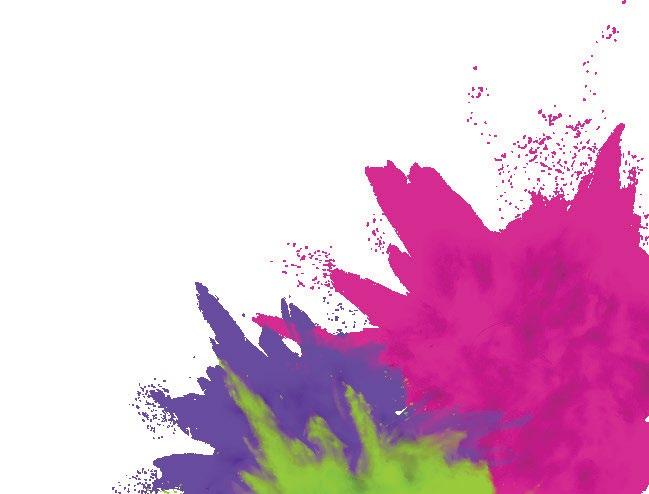

PUBLISHER
Pawan Luthra
EDITOR
Rajni Anand Luthra
CONTRIBUTORS
Torsha Sen, Khushee Gupta, Sruthi Sajeev, Apoorva Tandon, Krishna Neelamraju, Prutha Chakraborty, Srikanth Rajagopalan, Sajit Nair, Minal Khona, Sumathi Krishnan, Piyush Bhatt, Abhishek Goel, Gaurav Masand, Petra O’Neill, Auntyji
SALES AND MARKETING
Charu Vij
ADMN
Kanchan Majumdar
GRAPHIC DESIGN
Shailesh Tinker
Indian Link is a monthly newspaper published in English. No material, including advertisements designed by Indian Link, may be reproduced in part or in whole without the written consent of the editor. Opinions carried in Indian Link are those of the writers and not necessarily endorsed by Indian Link. All correspondence should be addressed to:
INDIAN LINK MEDIA GROUP
Level 25, 259 George St, Sydney NSW 2000 GPO Box 108, Sydney 2001 Ph: 02 9279-2004
Email: info@indianlink.com.au


JBY PAWAN LUTHRA
im Carrey’s 1998 masterpiece The Truman Show was a study in how reality can be manipulated. It showed our increasing obsession with celebrities, and ways in which alternate reality can be sold. Note that this movie was made before the rise of social media marketing and other modern technologies that now control our daily lives. If a movie were to be made today, it would not stretch the imagination to call it The Trump Show, given the narrative presented by the current United States President. Some of it has merit; a lot of it is founded on alternate realities — also known as lies.
Union and its socialist allies in the 1990s eliminated any significant opposition to US supremacy. For 25 years or so, in this unipolar world, the US held unparalleled global dominance, and exerted global influence. But over the last decade, China has emerged as a serious competitor to the US, signalling the reemergence of a multipolarity in the global order.
end to the long-standing US support for democracy, this leaves the door wide open to other superpowers who may have their own designs in their neighbourhood. China, for example has long argued that Taiwan is a part of its territory, and the apparent changes in US foreign policy may well embolden them to take the next step there.
Closer to home, Arunachal Pradesh in Northeast India has witnessed China's passive-aggressive strategy toward India, which could escalate into open conflict. What next - Himachal? Sounds highly improbable, but we do live in a world of alternate reality.
Watch also for any repositioning of the Seventh Fleet from Japan in the near future as a signal of geopolitical shifts in the region.
The proxy war being fought in Ukraine between the US and Western Europe on one side, and Russia, China and North Korea on the other, has been protracted and expensive for both factions. While it was widely expected that sanctions against Russia imposed by the West would collapse its economy, that did not eventuate, due to Russia’s support from China and to an extent India, as these countries kept up their trade momentum with Russia.




splash of colour can get your life flowing


Indian Link ’s editorial of last month (The Big Three reimagined) , in which we discussed the growing alignment of the US, Russia and China since Trump came to the White House, has initiated fierce debate among our readers. While some feel that this may be a long bow to draw, others have acknowledged that at times it does feel that the world is heading towards a 2025 version of the Yalta Agreement. This version, as argued in the article, will allow an understanding between the three superpowers to have a greater say in their parts of the world, Russia in Eastern Europe, the US in the Western Hemisphere and China in Southeast Asia.
The show orchestrated in the Oval Office during the infamous Trump-Zelenskyy-Vance meeting, in which the US President seemed to be singing from the Russian hymn sheet, certainly looked like an indication of a changing world order.
The collapse of the Soviet
The US has borne a significant economic cost over the last three years on the Russia-Ukraine conflict, although not $350-$500 billion as Trump repeatedly states, but closer to the $120 billion mark - while Europe has spent $138 billion. With the US now threatening to withdraw its support for Ukraine, the EU nations are being forced to increase their defence expenditure. This could well lead to internal tensions within the EU, if countries with more fragile economies or closer ties with Russia are not willing to come to the table.
More importantly, will this be the beginning of the end of NATO, which was set up in 1949 to push back against Russia's influence?
To mark the third anniversary of Russia's invasion of Ukraine, the US has twice voted alongside Russia at the United Nations, underscoring the Trump administration's shift in stance on the war. Indicating an

For Australia, there will be intense pressure to build up its military capabilities and spend more on defence.
Currently spending 2% of its GDP, the pressure is to increase it to 3% in the next 6-8 years. The increase from the current $56 billion to $130 billion will come at a cost, be it through higher taxation or reduction in government programs. One wonders if either of Australia’s two leaders will debate this issue in the forthcoming elections.
The increased expenditure on defence needs to align with Australia’s reality, i.e. vast areas of land and sea to defend, with limited population. Rather than spending this money on America’s military discards, it should be allocated towards smart warfare purchases.
As America wields power in an isolationist and self-interested way, global democracies must be resilient against the rise of authoritarianism.



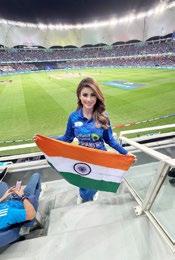




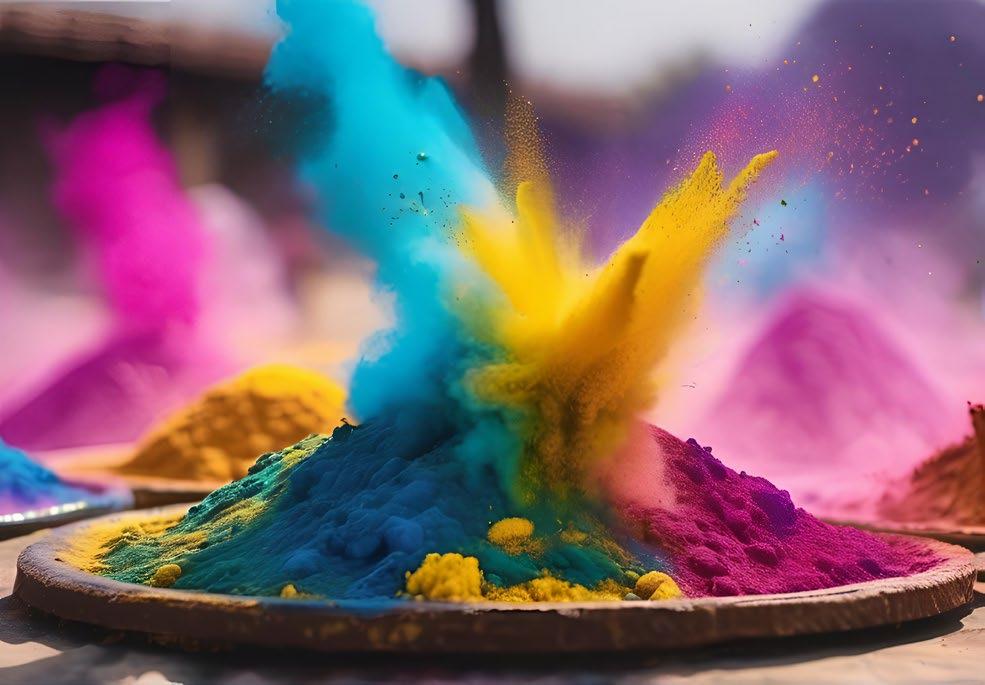










PAWAN LUTHRA spoke with CEO of Multicultural NSW Joseph La Posta on how far we’ve come as a multicultural society, and the new challenges that currently face us.
Melissa Monteiro wrote: Great interview Joseph. Fabulous questions Pawan. Love the points you make. It’s okay to have different opinions, maintain the laws in our country & be law abiding.
Jayaraman Guruswamy wrote: Interesting to listen to. I have known Joseph from day 1 of his joining MNSW; he has been a true advocate of social cohesion and multiculturalism.
Mala Mehta wrote: Great conversation, Joseph La Posta and Pawan Luthra Fotis Kapetopoulos wrote: Love this.
Joseph La Posta wrote: Thanks Pawan Luthra - you made me feel comfortable and engaged! I completely forgot we were even doing the interview and just felt like a chat. Always love connecting with you and the wider Indian Link Media Group.
Chas Wilkinson wrote: Which business, aside from Indigenous Aboriginal owned and operated businesses in Australia, isn’t a migrant-founded business? We have a beautifully diverse community which makes Australia such a unique country.
David Hayes wrote: An excellent interview, and Joseph was extremely articulate on our current environment. His last three comments were extremely poignant. It still disappoints me that less than 5% of Australia's top 50 consumer-facing businesses have multilingual customer engagement. They are denying such a treasure trove of new business.
Nasiba Akram-Haidari wrote: Some tough questions, yet a powerful response from a leader who truly believes in the strength of harmony and balance.
Tracey Holmes wrote: Joseph has always been worth listening to. Thanks for posting.
Türkan Aksoy wrote: Such brilliant leadership, Joseph.
Sriraman Annaswamy wrote: What an utterly unacceptable waste of taxpayer dollars. No wonder we have one of THE worst productivity growth rates in the world! This is a useless sinecure of a role that only serves as a springboard to a further political career or a CEO role on one mediocre partisan think-tank or industry association or the other. The only thing that organisations like Multicultural NSW, Victorian Multicultural Commission and such do, is nurture an insidious and parasitic eco-system replete with "multi-culti communication experts", "DEI gurus" and of course, event organisers and PR managers, presumably to promote their "amazing work", all paid for by the hard-working tax-payer's dollar. Time for an Australian and NSW and Victorian DOGE-style waste-busting organisation that can spotlight obvious parasitic ecosystems like these with laser-like focus and cauterize them, once and for all.
THIS OR THAT?
Readers are loving our new snap poll in the weekly e-newsletter! Here’s how the votes stacked up in the last three editions:
• South Indian vs. North Indian cuisine: 65% – 35%
• Gully cricket vs. Beach cricket: 75% – 25%
• Dry Holi vs. Wet Holi: 67% – 33%



In the lead up to Mardi Gras, KHUSHEE GUPTA spoke to queer couples, many of who find that visibility and representation in queer spaces are still evolving. Khushee Gupta wrote: An absolute pleasure speaking to these amazing people and learning more about love.
Rita Chand wrote: Absolutely LOVE this.
Andenave wrote: Love writes its own rules!
Trikone Australia wrote: What a special feature, with some very precious humans! Beaming big love to everyone for a safe and inclusive Mardi Gras! Our community has pushed so hard, so far – lots to celebrate, despite lots more progress to be made in South Asia.
Dom Thattil wrote: Absolutely love this feature!
Kashif Harrison wrote: Thank you for being an ally to our community. therav19, Figueroa Barroso, Girlon Safari, Rajni Anand Luthra, Danny Nour, whenshespeaksherheart, daughtersofkali, ashlei_ yadavthapaofficial, Adhirah Pradeep, the gyan girl, Torsha Sen, Therav 19, Smokeysound, Khushaal Vyas and Cherlynandsu_an also sent in notes of appreciation.
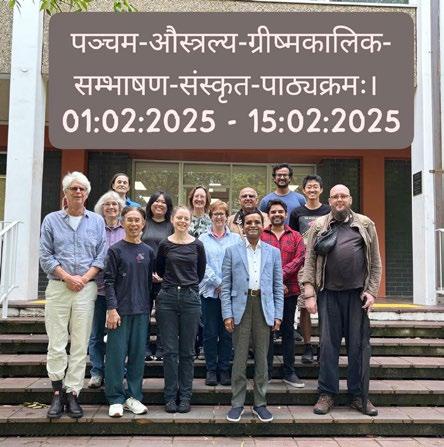
RAJNI ANAND LUTHRA reported on ANU’s Spoken Sanskrit Summer School which attracted participants of all ages and backgrounds.
Sriraman Annaswamy wrote: Dr Mccomas Taylor along with Dr Michael Comans (VasudevAcharya), formerly at Sydney University, are two outstanding Australian Sanskrit stalwarts who have rendered yeomen service to our Sanskrit and Vedic communities here. Not only are they outstanding language scholars, they have also developed an excellent understanding of our Scriptures, particularly Vedanta. We're truly blessed to have such scholars in our community here - more power to them.
Mahernaz Bengalli wrote: I had Sanskrit as a school subject growing up, and I did enjoy it! Loved learning the Shlokas.

PAWAN LUTHRA wrote about a possible new world order being crafted, given the scepticism towards the United Nations being shown by the United States, China, and Russia.
Maurice Newman wrote: The world’s balance of power is as you describe it, although I take issue with China exhibiting scepticism towards the United Nations. Chinese officials run four of the UN’s 15 specialised agencies. Washington, which contributes three times more than China and, more than 185 member states combined, leads just one.
The UN recognises China as a “developing” country and so, at the World Trade Organisation, it enjoys the same "special and differential treatment" as Zimbabwe and Haiti.
At a UN leaders’ summit, Xi Jinping committed China to limiting the increase in coal consumption over the five-year plan period, 2021-2025 and phase it down in the 15th five-year plan period, 2026-2030. Yet China started construction of 94.5 gigawatts of coal-fired power in 2024, the highest volume of new builds since 2015.
Chinese officials successfully lobbied more than 80 United Nations member countries to support China's opposition to human rights being used as a reason to interfere in other countries’ internal affairs.
China’s contempt for the UN would be a better word than scepticism. Meanwhile, Trump is looking to change the existing power balance by upsetting the China/Russia alliance.
He is also breaking with the former one-world paradigm which China was pushing through the UN and the WEF.
India will be a beneficiary of this rearrangement.
Its historical friendship with Russia and its critical defence significance to America will ensure accelerating economic growth and growing political influence. Australia was never the “deputy sheriff” - a term coined by President Bush but downplayed by John Howard. Australia can’t defend itself, let alone act as some Indo-Pacific policeman!
Otherwise I agree with your observations, although I doubt President Trump will appear in Red Square.
That would diminish him and the United States of America.
ANU SHIVARAM was at the launch of writer Sydney Srinivas’ latest book on Nobel Prize winning scientist Marie Curie.
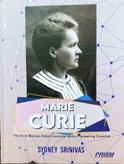
Veena Nair wrote: Marie Curie's biography was given to me by my mother as a reward for coming first in an elocution competition when I was in Year 4. Her story captivated me and it was then that I decided I wanted to be a student of Science. I will definitely read this book.

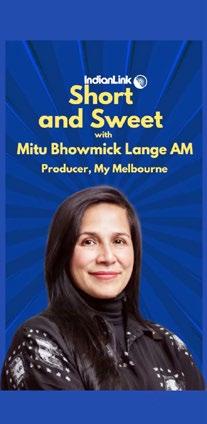





You liked TORSHA SEN’s reel in which she spoke to filmmaker Mitu Bhowmick Lange ahead of the release of her film My Melbourne.
Malaika Arora Official wrote: So proud of you my friend, Mitu. Neeru Saluja wrote: Love this! All the best Mitu Lange and the team for My Melbourne.
Nishka Bhagwat wrote: Loved hearing you speak (in this clip). So excited to watch the film. im_preets wrote: Best wishes Mitu and the team for My Melbourne. Looking forward to it.
pcb60 wrote: That was so fun to watch! I love the trams too.
Ashish Chawla wrote: Great work Team Indian Link, and great interview, Mitu.
Garyleecious, skinwith.rohini, balissimo, halder_bari and Deepak Narwala also wrote in notes of appreciation.

MANAN LUTHRA spoke with Sharath Nair, mixologist at Grain Bar, Four Seasons Hotel Sydney.
Darshak Mehta wrote: What an unusual but highly enlightening clip. Manan has some genuine intellectual curiosity and asks probing questions plus listens intently. Extremely impressive and MORE, please!

This building might seem ordinary when seen up close, but when looked at from a distance, the face of a prominent Indigenous elder is apparent.
Readers Deepak Vincent and Pradeep Taneja got the correct answer: William Barak Building or the Swanston Square Apartment Tower, in Melbourne.
Rajesh Dave wrote: Nice. Interesting slant on cultural insights, and good to hear about the trend towards sugar awareness.
It is the world's tallest statue, standing at 182 metres (597 feet). It honours Sardar Vallabhbhai Patel, a key leader in India's independence and unification. Unveiled in 2018, the statue attracts millions of visitors and features a viewing gallery, museum, and exhibition hall.

Readers Bhanu Kothari, Ankith Arun Aswath, Maurya Morya, and Chauhan Somesh had the correct answer: the Statue of Unity is located inKevadia, Gujarat.

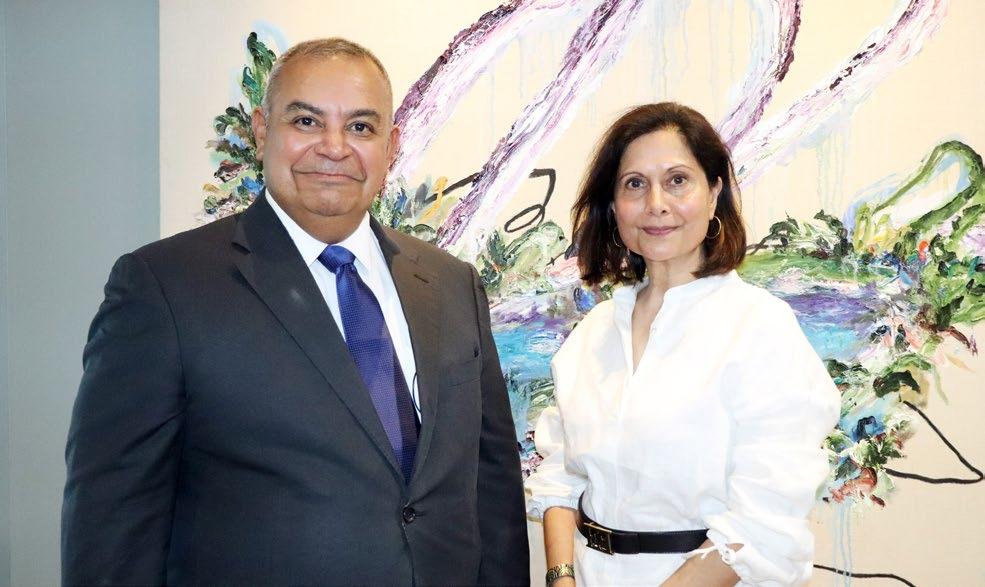
We know of Swati Dave as the Chair of Centre for Australia India Relations, and as recent appointee to the Governance Board of the Reserve Bank of Australia, the first Indian Australian to have this privilege. Here she tells PAWAN LUTHRA her backstory – from arriving in Australia as a child to building a successful career in banking and beyond.
Swati, your family migrated from Mumbai in 1971. You attended schools in country NSW and Mount Gambier in SA. How did your early experiences influence your professional career?
In all the places we lived, the thing that hit most starkly, is how we were so different to everybody else, because there weren't a lot of people of different cultural backgrounds in Australia at that time. I was always the different one - everyone else usually was very blonde and blue-eyed.
(As I grew up), I got much inspiration from seeing the way my parents took that punt to come to a different country and to build a new life for our benefit.
You were quite young to be that perceptive.
I've always felt to be older than my biological age in terms of the way I think about things. I'm also a very keen observer. I love to observe, and listen, and learn. I was observing the family dynamics. I was observing my father and seeing how he navigated a new environment. And how he showed great courage, resilience and determination. I felt quite emboldened by that.
There was always an understanding of the sacrifice on my parents' part, (so it was about) how do I make the most of this opportunity? How do I make them feel it was all worth it? That's always been the
driving force for me - not wasting these opportunities, which in a country like Australia are just immense.
You graduated in commerce from the University of Newcastle. Your father was a surgeon. Knowing a lot of Indian families, then and even now, was there a preference for children to do medicine or law? No. So here's the thing. I always thought I would be a surgeon. Because that's what my father was, and I wanted to be like him.
But one of the things I observed was, he was always working, we never saw him. And I didn't really want a life like that. I wanted a career as well as children, and I also wanted to be very present with my family. So though I did think of medicine, I self-corrected and decided to do commerce, because I thought that would give me a lot more options. And then I fell into banking. The CBA came to University of Newcastle, and offered me a role.
You entered banking in 1985 and spent 30 years in the fast-paced world of investment banking until 2015. Research from the University of Melbourne shows that, during this time, less than 6% of senior management roles in banks were held by women. Can you share your experiences and how you navigated a predominantly male-
dominated industry at the senior level?
I think my early experiences helped, because I got very comfortable with being different. It didn't bother me. It was like, yes, I know I'm different, and that's fine. But how do I leverage what I'm good at? I always loved learning. Being good at school and university, it gave me more confidence.
I’ve always thought, what is it that I can bring to a role? What am I going to contribute? So the fact that I was one of very few women didn't bother me at all. Of course, bear in mind, I was a young woman, also a married woman. I wasn't socialising in the way perhaps that other people my age were.
Did it work against you?
I honestly don't know. And actually, I don't care. I just threw myself into my work. With my great passion for learning, I've enjoyed being at the front end of new developments. Early in my banking career, I was doing a lot of project financing for resources, in Indonesia and in PNG, where I looked at potential mining project sites etc - when you're in your mid 20s, that's pretty amazing. You interact with a whole bunch of international financiers and you go, gee, the world is so large, and there's so much that's possible.
And from that, I was at the beginning end of the infrastructure boom in Australia. I was involved in the early transactions that were done in finance, in structuring and
financing the M2 toll road, which has been amazing for Sydney. And then I went on to work on the Melbourne City Link, which now, of course, is Transurban Plus. I don't worry about being different, or being the only woman, I just kind of focus on what I’m going to bring to my role.
What would your advice be to young women, especially of South Asian background, who may be in firms where the gender balance may not be equal?
I’ve always been very ambitious - in the sense of how do I make the most of my opportunities. But there's also resilience. Because, whilst you say I have this 30-plusyear career, and it's been amazing, things haven't always gone my way. There have been roles that I've wanted that I didn't get, or promotions that I should have had that I didn't get. But I don't dwell on them. I kind of go, yep, I'm disappointed, but then I move on. So you have to build resilience. You have to know that it's a learning process. You won't know everything, you'll make mistakes, but that's part of the learning. So you need to embrace all of it, the good, the bad, the ugly, everything. There's also persistence. If things don't work out, besides resilience, you have to be persistent and determined.
The other aspect for me, and a big learning through my whole journey is, you have to be really true to who you are. I'm
not saying you don't look at the context, don't appreciate how things are done, what the rules of the game are. You need to be aware of all of that. But you also need to be really clear about who you are.
What does that mean?
Well, you know, I’ve always been an introvert. And my style is one where, I like to observe and listen, and I will listen more than I speak. Because I think there's more strength in actually scanning and understanding the context. And so I've never wanted to be the one in meetings who always has to speak, or always needs to speak first. And, that's a stylistic thing, right? To be honest, I've had a few colleagues or bosses who've said, you have to speak up more, and you have to push yourself more. And I hear them and absolutely understand where they’re coming from. But I don't try and do it in a way that emulates other people. I make it work for my style. And I may amp up aspects of my style that I'm really comfortable with.
How do you handle disappointment?
I get a bit reflective for a period of time. And then I go, I have to snap out of it. And I'm also really lucky that I have an amazing husband, who is my great mentor, and also my great supporter. And he will give me a different perspective.
Having him there – we've been together now for 41 plus years – that is for me, the most wonderful thing.
Swati, in your experience, do glass ceilings exist? And if they do, how do you break through?
I stay away from that narrative for myself. I appreciate everyone's going to have a different perspective, and I'm not suggesting that my view is the right view. It's just what's worked for me. If I see an obstacle, I go, well, how do I solve it? And if I can't solve, I go around it.
I'm always thinking, what are the solutions for me to get to where I need to be?
Swati, it's often said it's difficult, for women especially, to have it all - successful careers, family life and relationships. Yet you've managed to juggle it all successfully.
I don't know about successfully… I have a husband who has a great career of his own, but we were both very aligned in terms of wanting to be great hands-on parents. We both have careers, and we're both involved in parenting, and always have been. I think that sets up a great foundation. We both think that careers are forged over a period of time. So there was no unrealistic expectation that I must get to this role by this age or this stage in my life. We had our children three years in a row, which was madness – but we got into a routine and a rhythm. It was a manic routine - I was super busy, for example, working on Melbourne City Link, I would be away for six months and do Monday to Friday in Melbourne, which meant my husband had to (care for) the kids. This was before any policies in organisations around
flexibility, maternity leave, all of that stuff, so you had to do everything on your own. And it was hard, and very expensive - with three kids in day care, and having to hire help when we were both really busy. All those things weren't very conducive to staying the course in terms of building a career.
But did it make you ever doubt what you were doing? Because earlier you said your surgeon dad was busy a lot… It was kind of strange, like, you know, fate is kind of laughing at you! Because you thought you were avoiding something, but you ended up there. I think it comes down to your own personality, in your mindset, that whatever you do, you want to do really well, to give it your best shot. But as the kids started getting older, it helped.
One of the things I've done quite a bit throughout my career is consider, what's important for our family at this point in time. And so I've said no to C-suite roles, when my kids were at an age where they needed me to be more visible. Like when my first son was moving to high school, or when my parents moved in with us because my father wasn't well, I was offered roles, once in another country. And I said no.
These are choices that we made as a family around what was important.
In 2015, you mentioned it was time to take on board positions — about 30 years into your career. Was this a conscious goal, or were you naturally steering yourself toward roles that aligned with your ultimate destination? Two things have been really important for me. One is, doing things that have a great purpose, where I can align with the purpose. In my role at NAB, for example, we were financing schools and hospitals and roads and things, things that you need in a community.
The second is, making sure that I make a contribution. Can I contribute to my team? Can I contribute on a particular transaction I'm working on? Can I contribute to my employer? Can I do something for the community? Can I do something at a more global scale? For example when I was an executive at NAB, I was on the board of Australian Hearing, a federal government agency. I loved what they did - they had all these passionate people who wanted to do so much for people with hearing problems. So when I stopped my banking career to focus on board roles, I sought roles that had some meaning for me.
Let's talk about qualities in successful corporate leaders. Who inspires you, and why?
Inspiration comes from everywhere – from people I’ve worked with, people who’ve worked for me, my bosses throughout my career, and people in the community who do what they do.
In terms of qualities, more than people, it's authenticity, integrity, and intelligence (emotional and social), caring for people, having respect for people, being compassionate.
Successful leadership is also about
‘Authenticity. Integrity. Social and emotional intelligence. These are leadership qualities that inspire me.’
giving people the kind of the climate and the culture that helps them to succeed. I think that's really important - helping them realise their potential. I want them not to waste the opportunity. And I want to equip them to be able to do all of that stuff. It's a combination of that and the real outcomes focus and the performance focus, and marrying those together.
Swati, there’s a sliding door moment in our lives where the right decision elevates us. Which was yours? Oh, without a doubt, proposing to my husband.
You proposed to him? I did indeed.
Talk to us through that scenario. I met my husband when I was 12 and he was 14 or 15. And I just knew in my heart, this is the person for me. Of course, that was me as a child. We didn't see each other for a long time, because he was in Newcastle and I was in Mount Gambier. But when we moved back to the East Coast as a family, we saw each other a bit more often. And by the time I was 17, I was like, this is what I want.
Did he know?
Of course, he knew. And the rest is history. For me, if that had not happened, I just cannot imagine what life would be like.
Coming back to your career, Swati, how has your background and experience as a migrant influenced your leadership style and business strategies?
Well, you develop a lot more compassion for people from all walks of life. You're very aware of the need to be truly inclusive. You want to help people get the leg up in life. But I did not go into it thinking I only want to do that for people from different cultures or from different genders or anything. I wanted to do that for everybody.
Research has shown that diversity increases productivity. Yet trends indicate that diversity might actually be an unfashionable term these days. Your view on this?
I think if you understand the premise
challenge from many different perspectives, so that you can have a really holistic way of thinking about it and coming up with the solution, then it is not something that's fashionable. It's something that you bring to the table, because you actually want to drive innovative and progressive outcomes.
Now, what three pieces of advice would you give to a young employee, fresh from university, starting off in a large organisation?
One, have a sense of purpose. It's your why. Your why is really important when things go wrong and you question yourself.
Two, find a role where you can learn a lot.
Even at the cost of perhaps a higher pay? I think it's really important to learn. You need to keep building your skill set and evolving yourself as a person. And that helps you adapt to different circumstances. Given where we are, in terms of all the changes that are happening in the world, that is even more important now. My own career wasn't linear. I took on a lot of different roles because I wanted to learn something new.
Three, learn to be part of a team. You need to get along and play well. If you’ve been a good follower, you can be a much better leader.
A management principle you live by? I don't expect people to do anything I wouldn't do.
What about work-life balance?
Yeah, look, I don't know that there's such a thing. I think different things become more pressing at different points in your life. Life is about trade-offs. It's about what you want at a point in time. So, yes, you can take that role that makes you a lot of money and gives you lots of profile. But what are you giving up? Or are you giving up anything? These are all choices people need to make for themselves. I've made choices where, yes, in the early days when my kids were young, there were things I had to do, because if I didn't do them, I wouldn't have a job. Because, you know, there was no maternity provisions - they didn't have to keep a job for you.

How do you celebrate success?
Well, I've learned to do that a lot better. In the beginning, I would buy something for myself. Now it's experiences - where shall we go on holiday? I think it's important to celebrate successes, no matter how big or small. You're encouraging that part of you that wants to know it's doing well.
To more celebrations and success in your life, Swati.
Thank you very much.

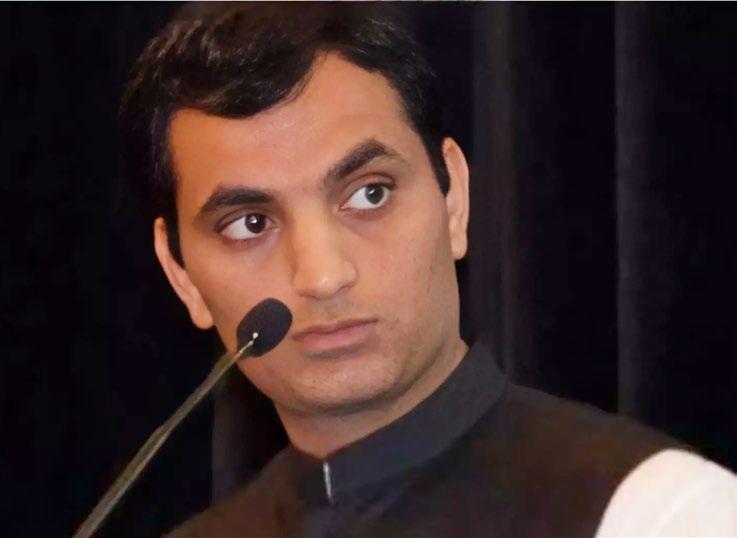
Once seen as a model for New Australians, the Indian community here could now face the fallout of shocking predatory crimes, write KRISHNA NEELAMRAJU and RAJNI ANAND LUTHRA
Late 2014, as India’s Prime Minister Narendra Modi made his first visit to Australia, Balesh Dhankhar was a busy man.
As an integral part of the Indian Australian Community Forum (IACF) which was founded overnight to organise the prime minister’s community reception, Dhankhar was quite the man of the moment, in demand by various sections of the community, including the media.
Fast forward to 2023, as the same frenzy enveloped the community to welcome back a worshipped prime minister, Dhankhar was locked up in jail, condemned by a community that was in his thrall in his perceived closeness to the ruling BJP and the Indian prime minister.
Bursting into the limelight following Mr Modi’s 2014 visit, Balesh would go on take his organisation the Overseas Friends of BJP to some heights, launching in other states etc, as well as participating in other community organisations like the Hindu Council of Australia, representing them at mainstream events and undertaking speaking roles.
But behind closed doors, he was a predator lurking in plain sight.
Followed by a much-publicised sexual offences trial, Balesh was found guilty of deceiving, drugging, and filming young Korean women as he raped them.
This week, he was sentenced to 40 years in prison.
It was a case that shocked the community

when it came to light. Dhankhar’s crimes were as calculated as they were disturbing. He used fake job ads to lure young South Korean women to his luxury apartment, drugged them, and then sexually assaulted them while filming the attacks. A police raid uncovered a sickening collection of videos and a spreadsheet where he rated potential victims on their vulnerability.
The judge, Justice Michael King, called his crimes “premeditated and highly predatory,” handing him one of the harshest sentences in recent history.
“Balesh Dhankhar has rightly been sentenced for a 40-year prison term for his premeditated, despicable and egregious
community groups, his crimes may sadly taint our community in Australia."
Sue Advani, President SEVA International Inc, had told Indian Link in 2023, “The Australian Indian community is deeply shocked by this incident. While no community or culture is immune to such a wanton and disgraceful crime, it is a very disturbing and uncomfortable feeling.”
Just like in 2023 when the conviction was made, no statement has been forthcoming from either the Hindu Council of Australia or the OFBJP regarding the sentencing this week, distancing themselves from the individual in question. While unconfirmed reports suggest that HCA did so soon after the initial allegations surfaced, no official statement has been issued.
It is true that no organisation can fully vouch for the personal conduct of its officebearers, or indeed their activities outside of their organisational roles. However, a public response would have been a welcome gesture - reassuring a community facing online abuse, and making it clear to the broader public that such criminal behaviour will not be tolerated.
In a chilling coincidence, Balesh Dhankhar’s conviction came on the 10th anniversary of the murder of Prabha Arun Kumar, an Indian woman brutally stabbed to death while walking home from work in Sydney. A decade later, the issue of violence against women remains as urgent as ever, with Dhankhar’s case serving as a grim reminder that the threat doesn’t always come from strangers in the dark—but sometimes from those who hide in plain sight.
Dhankhar isn’t the only Indian-origin predator making headlines. Adelaide masseur Sumit Satish Rastogi, 36, has also been unmasked as a serial predator, accused of more than 100 sexual offenses against 40 women. Working at 4 Ever Massage in Glenelg, he used his job as a front to abuse clients, secretly filming them and committing indecent acts. Police found more than 700 indecent images on his phone, suggesting up to 200 potential victims. Rastogi has pleaded guilty to nearly 100 charges, with a sentencing hearing expected soon.
For decades, the Indian-Australian community was seen as a model for new Australians - law-abiding, hardworking, and deeply family-oriented. But the rise in cases like Dhankhar and Rastogi has sparked uncomfortable questions. Are these isolated incidents, or is this a disturbing trend?
crimes,” Dr Yadu Singh, Secretary & spokesperson, Federation of Indian Associations of NSW told Indian Link. “Our thoughts and prayers go to the welfare of his victims and their families. Our community is largely a peace-loving and law-abiding community. There are however a very small number of people in the community who commit crimes including white collar crimes. These low-lives however, do not, and cannot, define us. Reports of these crimes are often covered in the media and unfortunately do end up throwing bad light on the name and reputation of the community. Due to Balesh’s previous high-profile links and leadership positions with OFBJP Australia and other
Either way, the damage is done. The challenge now is for the community to not only rebuild trust but also confront the uncomfortable truth - predators exist everywhere, even among those once thought to be above suspicion, and perhaps some negative proclivities are being brought to Australia that threaten safety for all. As we mark International Women’s Day, a sobering reality stares us in the face - India ranks in the fourth quintile for women’s safety. In the Georgetown Institute 2023 Women Peace and Security Index, India ranked 128th out of 177 in 'Women Peace and Security Index'. According to India’s National Crime Records Bureau (NCRB) 2022 report, a staggering 4,45,256 cases of crimes against women were registered in India, translating to roughly 51 cases every hour.
Perhaps we need to put some thought towards what we are doing at the national, community and family levels, to teach respectful relationships.
How Sydney-based cyber criminologist
Nakshathra Suresh is helping make the digital world safer for all

TBY PRUTHA CHAKRABORTY
he world of true crime has exploded in popularity, thanks to a wave of podcasts, documentaries, and books inspired by real-life cases. Online sleuthing communities, driven by the thrill of solving mysteries, reopen cold cases and piece together clues from behind their screens. But few turn their interest into a full-time profession.
Sydney-based Nakshathra Suresh did.
From helping businesses tackle techfacilitated crimes to advocating for ethical digital safety, she transformed her passion into a mission: making the online world safer for all.
“As a proud woman of colour, with English being my third language, I am inspired to create a safer digital world for everyone, regardless of their skill or ability to navigate online environments,” Nakshathra tells Indian Link. “I advocate for the marginalised groups that I am part of, and elevate the voices of those in other groups who do not have the ability to do so.”
Her approach to digital safety is rooted in her lived experience – at a young age, Nakshathra experienced cyberbullying.
“Through my years of watching Bones, Law and Order: Special Victims Unit and Criminal Minds, I transferred from psychology to criminology in the middle of my first year at university,” she says. “In my postgraduate degree in criminology, I chose to work on stranger-based stalking and cyberstalking in Australia for my research dissertation.”
Today, Nakshathra is considerably younger than most of the other voices in the digital safety landscape. Last year, she was named finalist for the ‘Emerging Leader’ in Tech category at the Women’s Agenda Leadership Awards.
“Sometimes, you forget the impact of the
work you are doing, and then something incredible like an award nomination comes your way, and you think, ‘Oh, I’m actually being recognised’,” she says, adding she was “super thrilled” to receive the recognition.
Nakshathra is the co-founder of eiris – a tech consultancy firm that helps companies put humans at the centre of their technology.
The idea for eiris came after many conversations with founders and investors.
“I realised that Australia was far behind the ‘adopting technology safely’ movement that I had seen being discussed in America and Europe,” she explains. “We also realised that small to medium businesses did not have enough money or resources to invest in safety initiatives, even when they were passionate about ensuring their customers and consumers were not harmed by their services.”
Ranging from physical wearables, instances of online sexual harassment to over-reliance on AI chatbots, eiris helps founders understand the human impact of integrating these types of tech – which can vary from ethical, psychological, social and criminal outcomes.
“We help empower companies to feel more confident about using tech and help them understand the consequences of failing to implement risk mitigation strategies.”
Cybersecurity and criminology are often seen as male-dominated fields, but Nakshathra lets her work do the talking to break these stereotypes.
“While there are plenty of women who are software engineers, developers and technical experts in this space, there is a very small number of female and nonbinary social scientists, psychologists, criminologists and philosophers who take up room in this field. This might be a bit of a hot take, but I do believe the South Asian community looks down upon those


who pursue careers in the arts or social sciences,” she shares, strongly advocating for creating and forging one’s own career.
“I think it is extremely important for young women who are passionate about cyber to consider all the various career paths that they can take, and not just stick to social norms and be afraid of pulling that chair out at the table! The key is to advocate for yourself.”
Today, Nakshathra is a frequent speaker at public forums on a wide variety of topics, including ethics, harm reduction principles, Metaverse and AI.
“If I didn’t find power in being a minority, both race and gender-wise, this type of success would have never found me!” she says, smiling.
Very recently, UNSW, her alma mater,

asked Nakshathra to build a curriculum for a third-year criminology course, in conjunction with law and engineering concepts.
“In June this year, UNSW will introduce an elite course called ‘CRIM3040: Criminological Perspectives for Cyber Security’, which will introduce criminology and criminal justice students to the multifaceted realm of cybersecurity, exploring its core elements within the context of criminological, legal, policy, and regulatory frameworks. It is the first of its kind to be offered in the undergraduate criminology program, which means there will be more cyber criminologists and interdisciplinary scholars in the future!”
The cyber threats faced by women in Australia are often sophisticated.
“The trends we see involve less of stranger-based abuse and more of intimate partner violence, as the rates of domestic violence are devastating in this country. The rates of reporting in Australia also fare significantly better than India, where underreporting is rampant. India, and the Global South overall, have weaker protections and infrastructure, and has poorer economic conditions in which their governments and societies operate. Women in Australia are also likely to have used different types of digital platforms than those in India, where there is a struggle to even gain access to the internet in regional areas.”
Nakshathra’s work requires tackling difficult, sometimes traumatic cases. But there has never been a lack of motivation for her to continue her work.
“In fact, what drives me is the collective failure of the world to protect those who are most vulnerable to cybercrime.”



































































































































































































































































































































Proudly honoured with 31 media awards, including four-time recognition as Best Publication.
Three decades of all things Indian. In Australia.


ABY RAJNI ANAND LUTHRA
s days passed for Monica Dhingra in hospital, gravely ill following a stroke, a health professional gently asked her family a question.
Her husband Rajinder and children Cherry and Anmol knew time was running out for the deeply loved matriarch.
“Yes,” Rajinder Dhingra spoke for his family. “We are happy to donate Monica’s organs.”
Mrs Dhingra may have passed on 31 Dec 2024, but she lives on – in seven other people who got a new lease on life from her organs.
Even as they grieve for their beloved mum, Cherry and Anmol are filled with pride for her last and selfless act.
“Dad may have spoken on behalf of us all at the hospital,” Anmol Dhingra told Indian Link, “but really, he was speaking as Mum on that day.”
He went on, “Weeks before she had her stroke, Mum had brought home a form for organ donation from Compassionate Hand, a not-for-profit community organisation she was deeply involved with. Although she did not fill it in, it was clear the idea had crossed her mind. We are so grateful to Dad for remembering this when asked, even though at the time our hearts ached for Mum’s health and we prayed for her recovery.”
Her last gesture has come to define Monica Dhingra’s eventful life, forever reaching out to help.
Well-known in Melbourne’s Indian community, particularly the senior community, Mrs Dhingra was a beacon of light wherever she went. Soon after becoming a permanent resident in 2015, she began to engage herself in various groups, always willing to help. Very active, she started driving and became independent, even taking on a career for the first time in her life, in security. Within the community, other than Compassionate Hand, she found value and served in the seniors’ organisation NRISA, Indian Aus Association (Selandra Rise, Clyde North), SEWA, ISCA, Sahara, Asha Global Foundation, was actively involved in events organised by the Consulate General of India, and even became a member of the Australian Labor Party.
A passionate follower of the Art of Living movement, she spread its word about the benefits of meditation far and wide.

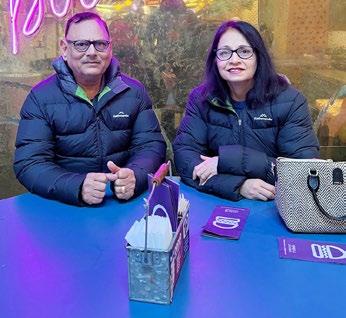

Seven people have had a new lease on life as a result of Monica ’s organ donation

Anmol recalled, “She would walk twice a day, and often times, she would start talking to strangers and then bring up the topic of meditation! I’d say, mum, stop embarrassing me… and she’d reply, one day you’ll realise the positives. And it’s true, since she’s gone, meditation has helped me like nothing else.”
Monica’s disposition for helping others was a trademark quality even in India, Cherry chimed in. “Born and brought up in Chandigarh, Mum moved to small-town Phagwara after marriage. It was a hard
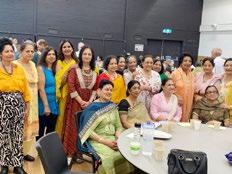
transition, but she did her best to live her life and engage in various developmental activities. She became Chairperson of Jaycees and President of the Lions Club, ran various eye operation camps and donated blood multiple times.”
In hindsight, it is not at all surprising that donating was her last act on this earth.
“Dad, Anmol and I sat down and planned how we can help someone get a life and what organs we can donate,” Chery told Indian Link.
“The operation for organs lasted five
hours, and we were notified when it was concluded successfully. Two days later we got a call to let us know how Mum had impacted people.”
Four fortunate people received lifechanging transplants: both lungs went to an adult female, liver to an adult male, and the two kidneys to an adult female each.
Two recipients will soon receive Monica’s corneas, and one her heart valves. Her heart has been stored for cardiac tissue transplantation.
In Hindu mythology and philosophy, the concept of ‘seven lives’ holds deep spiritual significance, primarily in relation to reincarnation, karma, marriage. Hindu belief is that a soul takes at least seven lives (or more) to evolve spiritually and break free from the cycle of birth and death (moksha, or Emancipation). Perhaps there is some solace in this for the Dhingra family given Monica’s own life, so dedicated to service, and the seven lives she deeply impacted as she bade goodbye.
Regardless, Mrs Dhingra’s benevolent end-of-life gesture is giving the Dhingra family a renewed sense of purpose in their own lives.
Here’s a note, reproduced in full, that Cherry and Anmol have written to all those who sent in condolences and messages of support:
To all our senior citizens: Stay connected, cherish your friendships, and take care of your mental well-being. Life is ever-changing, but the love and support of those around you can bring comfort and healing. Speak, share, and let others be there for you.
To everyone else: Listen to seniors, support them, and extend a hand to those who may be feeling lonely. A simple conversation, a visit, or even a kind gesture can make a world of difference.
And to all the children who lovingly care for their parents: You are doing something truly irreplaceable. No one can ever take the place of a mum or dad, and your love and dedication mean more than words can express.
Let’s spread kindness, love, and warmth to those who need it most.
We are lucky to have had our parents with us for the last nine years and see our marriages, new homes, our children (their grandkids) and our careers flourish. Of course we want our parents to live for a hundred years. Now we have Dad to give us both a father’s and a mother’s love.






Youth and health advocate, Melbourne
What progress would you like to see for women in the next decade?
Aayushi: I’d like to see tangible, systemic progress in areas where women have been historically disadvantaged - starting with reproductive rights, safety, and economic equity. Abortion access should be universally recognised as a fundamental right, not a political bargaining chip. No woman should be forced to carry a pregnancy against her will, and reproductive healthcare should be accessible without stigma or barriers.
Pay equity is another area where progress has been frustratingly slow. It’s not just about closing the gender pay gap - it’s about valuing work traditionally done by women, ensuring parental leave policies allow men to share caregiving responsibilities, and dismantling the biases that keep women from leadership roles. More transparency in pay structures and stronger workplace protections are necessary to prevent systemic discrimination.
Priya: I’ve personally seen how the system fails women, especially when it comes to domestic violence. Women aren’t taken seriously, and the numbers are shocking. 13 women have already been killed this year, and 104 were killed in 2024. This isn’t just a number; it’s a crisis that’s already happening. The fact that so many women are losing their lives means we need systemic change now, not later.
Law enforcement needs to be held accountable for how it handles domestic violence cases. Too often, women’s complaints are dismissed, and abusers are not held to account. It’s crucial that those who perpetrate violence against women face consequences. Abusers should not be released on bail, and there should be tougher penalties in place. The legal system must take women’s rights and safety seriously to ensure real protection.
Beyond that, pay equity is still a long way off, and women in sport are still fighting for equal treatment. Reproductive rights need to remain with women, not be dictated by anyone else. Over the next decade, we need real action, not just more talk.
Joanna: The next decade must be about dismantling deeply ingrained structures that continue to hold women back - whether in the workplace, in relationships, or in society at large.
Women are still paid less than men for the same work. They perform the majority of unpaid labour at home, and in many cultures, they are still expected to sacrifice personal ambitions for family responsibilities. Meanwhile, domestic violence remains a silent epidemic, with many women - particularly migrant women - trapped in abusive situations due to financial dependence, visa restrictions, or cultural stigma.
Growing up Indian, I was told that my
Semi-professional footballer and dhol player, Sydney
purpose in life was to get married, have children, and take care of a home. My version of rebellion was refusing to learn how to cook, because I didn’t want to be boxed into a role I never chose for myself. But rebellion shouldn’t be the only way to carve out freedom.
Over the years, I’ve unlearned many of these internalised expectations. In my marriage, I am determined to break these gender stereotypes - creating a partnership where both of us contribute equally, in ways that play to our strengths. (In reality, my husband is the one who enjoys cooking and grocery shopping!) This is the future I want to see: a world where men and women are true partners, where labour - paid and unpaid - is valued equally, and where women are not expected to carry everything alone.
For migrant women, in particular, progress must include breaking cycles of control - whether that be through access to financial independence, education, legal protections, or simply changing cultural perceptions that dictate what women can and cannot do.
Natasha: In our own mental settings, we have normalised and internalised our tradeoffs – around family, space, entitlement, rights, voices, aspirations and emotions. We’re all wired with “negativity bias” that drives us to focus more on what we are not, than on what we can be; more on what could go wrong, than on what we could
make more right; we focus more on what we don't want than on what we do. So, a crucial key learning for me through my own journey has been – to use and grow the power we women already have innately. To challenge how we see ourselves, how we speak about ourselves, and what we see as possible for ourselves. I look forward to seeing women embracing their innate power, challenging self-doubt. As more women embrace their power, it will change the nature of power. I believe every day at home, in our workplaces and the world around us, through our actions, and in the way we lead, talk, question and act, we challenge norms and transform habits. The choice of being subjected to stereotypes and prejudices is ours. Do not let others define you. Own your strength. Own your story.
What role can women play in supporting other women?
Aayushi: First, we need to reject the idea that women’s rights are solely women’s responsibility to defend. Men need to be held accountable for dismantling toxic masculinity and supporting gender equity, rather than leaving women to do the heavy lifting. That said, women supporting each other is powerful. Solidarity is more than just social media activism - it’s about showing up in real ways. It’s about ensuring no woman is left to navigate discrimination, harassment, or violence alone. It’s about mentorship and sponsorship in workplaces,

BY KHUSHEE GUPTA
As we celebrate the 114th International Women’s Day, many women across the world continue to face systemic barriers, from the persistent gender pay gap to the alarming rates of domestic violence and decreasing autonomy over their bodies. In Australia, women still earn significantly less than men on average,

and access to healthcare, workplace safety, and legal protections remain uneven - especially for women from marginalised communities. Here, we explore the challenges that still lie ahead, and the women actively shaping a better tomorrow. Because while history has shown us how far we’ve come, it’s the work being done today that will define the future.
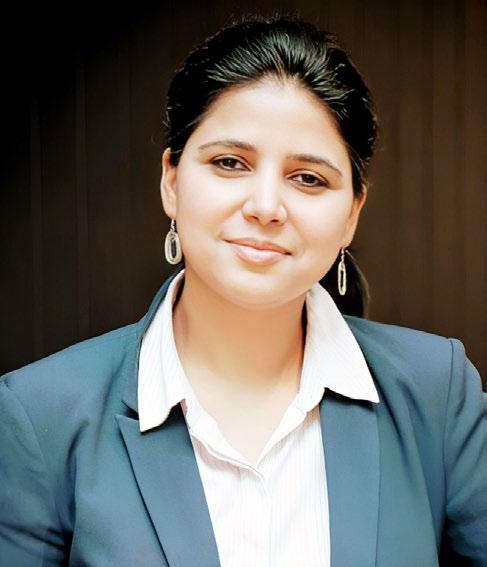
advocating for fair policies, and ensuring marginalised women - especially women of colour, disabled women, and LGBTQ+ women - aren't excluded from feminist conversations.
Women also need to feel safe disagreeing with each other. There’s often pressure to present a united front, but real progress happens when we challenge our own perspectives and acknowledge intersectional issues. Feminism needs to be more than just corporate slogans - it has to be uncomfortable, transformative, and deeply personal.
Priya: What’s happening in the USattacks on abortion rights, the rise of toxic masculinity, and women losing control over their own bodies - should serve as a warning to us all. We’re already seeing similar ideologies creep into Australia, and if we’re not careful, we could lose our rights too.
Women can make the biggest impact by supporting one another. Believe women when they speak up, and instead of tearing each other down, we should be lifting each other up. It’s about pushing for real change, challenging double standards, and making sure we don’t let the same things happen here. When women stand together, there’s nothing we can’t achieve!
Joanna: Toxic masculinity thrives on control. We are seeing this not just in policy changes but in the growing backlash against women’s rights - whether that be in
workplaces, in homes, or in online spaces. When women push for pay equity, they are told they are asking for too much. When they demand safety from harassment, they are told they are overreacting. When they advocate for their bodily autonomy, they are accused of wanting to disrupt the "natural order."
For migrant women, this issue is compounded by cultural pressures. Many women I’ve worked with - especially in my time as a refugee lawyer - were trapped in violent marriages because they had no financial independence or because their visa status was controlled by their abuser. Many stayed, not out of choice, but because they feared what their families and communities would say if they left.
This is why progress cannot just be about changing laws. It must be about changing mindsets. If we want a future where women are truly equal, we need to challenge the deeply ingrained beliefs that say men should lead and women should follow.
Natasha: Champion other women. Honour their journey. Create opportunities. If you have influence, use it to uplift women. Lift as you climb.
What’s one thing you wish every man knew about women?
Aayushi: That women are tired. Tired of having to justify why we deserve rights. Tired of modifying our behaviour to avoid
danger. Tired of explaining the same things over and over again. I wish more men understood that gender inequality isn’t just a headline or a political debate - it’s something women navigate every single day, in ways that might be invisible to them. Whether it’s walking to our cars with keys between our fingers, being interrupted in meetings, or dealing with medical professionals who dismiss our pain, the weight of these experiences accumulates.
But I also wish more men realised that change doesn’t require grand gestures - just listening, learning, and using their voices when it matters.
Priya: I wish men understood how much women deal with every day, whether it’s managing conditions like endometriosis, which often leaves us in pain while we still show up to work, fighting for equal pay in every industry (including sport), or simply trying to feel safe walking home at night. Women aren’t asking for special treatment; we’re just asking for the same respect, pay, and rights that men often take for granted. It’s about recognising that the challenges women face are real, and that change requires more than just words – it requires action.
Joanna: For too long, women have been conditioned to believe there are only a limited number of spaces at the tableespecially women of colour. This scarcity
mindset makes many feel they must compete against other women to succeed. But this is a false narrative designed to keep us divided. Instead, we must actively uplift one another. Every woman who breaks a barrier should be holding the door open for the next. Every woman who gains a platform should be using it to amplify more diverse voices. True progress happens when we create more seats at the table rather than protecting our own place in a broken system. As for men, I wish they knew this: equality is not a threat. Women are not asking for power at their expense - we are asking for the same opportunities, the same respect, and the same ability to live without fear.
Women already do more with less. They are expected to work outside the home while also carrying the majority of domestic labour. They juggle careers while being the primary caregivers. They push for success in workplaces where they are still undervalued.
The fight for equality is not about taking something away from men—it’s about creating a world where women are no longer expected to bear these burdens alone.
Natasha: I see true allyship as something built through consistent actions. The strongest allies listen, advocate, and stand up against inequality, even when it’s inconvenient. Support means more than words - it’s about commitment to fairness and respect every day, creating a world where everyone can thrive together.

Less-explored angles on Trump, Ukraine and WW3: Unveiling hidden agendas from China's European gambit to India's quest for global equilibrium

IBY SRIKANTH RAJAGOPALAN
n a world awash with narratives about Trump, Zelenskyy, Russia, NATO and the EU, it is easy to overlook perspectives that could enhance our understanding of the war clouds gathering today. Mainstream debate focuses on the interplay of a few actors, ignoring others.
The EU’s new dates?
As American politics veers towards a diametrically opposite stance from the past 80 years, China appears ready to capitalise on shifting global dynamics - especially in Europe. Since at least 2020, Beijing has been pushing for European strategic autonomy. In the last month, Europe has reciprocated, and sought a thaw in its relationship with China. Separately, it has committed to a free-trade agreement with India by the end of 2025. If completed, the India-EU trade agreement would be the largest of its kind.
Historical parallels also provide a cautionary lens on today’s diplomacy. Comparisons between President Trump's approach to Russia and the appeasement policies epitomised by the 1938 Munich Agreement have begun circulating, as highlighted by The Australian. The suggestion is that concessions to avoid conflict might embolden potential aggressors, allowing them to dictate terms. This could pave the way for future, bigger escalations, and
render NATO even more impotent than it already is. NATO, founded in 1949 with a promise of collective defense against Soviet advances, has long held that an armed attack against one is an attack against all, underpinning a framework that assures mutual protection. Yet a deeper inspection reveals a two-tiered commitment: while member states are expected to allocate at least 2% of their GDP to national defense, many have failed to do so. Are defaulters entitled to protection?
Furthermore, should Ukraine, which is not a NATO member, receive support under this alliance at all? Also, how can the EU, which cannot even meet its 2% commitment for the most part, even dream of supporting Ukraine on its own?
Ukraine’s security assurances were not enshrined in any collective defense commitments but came about through non-binding promises in the Budapest Memorandum on Security Assurances. Russia, which signed the memorandum and promised to honour Ukraine’s borders in 1994, has been in continuous and clear violation since then. This is clearly a massive betrayal of the Ukrainian people.
The internal divisions within the EU further complicate the West’s unified response to external threats. French President Emmanuel Macron’s recent attempts to rally European nations towards a single defense strategy underscore growing tensions. The extent of military support for Ukraine reveals fissures. They reflect historical legacies, economic priorities, and national security doctrines that vary greatly from one nation to another. Coupled with these institutional challenges is the ever-evolving influence of public opinion. In many EU and US countries, domestic discontent over prolonged conflicts and economic strains shapes foreign policy, adding another layer of complexity to international decision-making arenas.
Media narratives also play a role in shaping perceptions and policy decisions. They set agendas, dictate what the public perceives as priorities and influence how national leaders approach crises. For instance, while Trump’s rhetoric dominates world news cycles, the quieter stories of strategic shifts in Europe or Asia remain largely in the background. This imbalance not only distorts public understanding but might
Concessions to avoid conflict might embolden potential aggressors, allowing them to dictate terms. This could pave the way for future, bigger escalations, and render NATO even more impotent than it already is.
also obscure critical discussions on other security strategies and defense spending obligations that are fundamental to understanding the bigger picture.
The India wildcardthe bigger
Finally, an emerging viewpoint comes from India, a nation frequently sidelined in Eurocentric discussions. India's Foreign Minister, S. Jaishankar, famously stated that “Europe has to grow out of the mindset that its problems are the world's problems, but the world's problems aren't Europe's problems”. This shows a call for a more balanced outlook, with equal urgency to crises worldwide. As such, Western preoccupations with Ukraine and Russia might benefit from recalibration: instead of looking at one conflict, a more inclusive global framework would address security challenges across multiple regions simultaneously. This way, an overly deep focus on one area will not catch the world unawares if other nuclear flashpoints (think Middle East, Korea or India-Pakistan) or long-standing wars (Myanmar, Sudan, etc.) suddenly explode.
Popular narratives about current global political dynamics have centered on a small set of actors, yet other perspectives also matter.
Examining China and India’s moves, drawing historical lessons from appeasement, dissecting internal EU divisions, scrutinising the influence of media, and incorporating India’s global vision will deepen our understanding of the complexities and help us adapt our strategies if we want to avoid WW3.

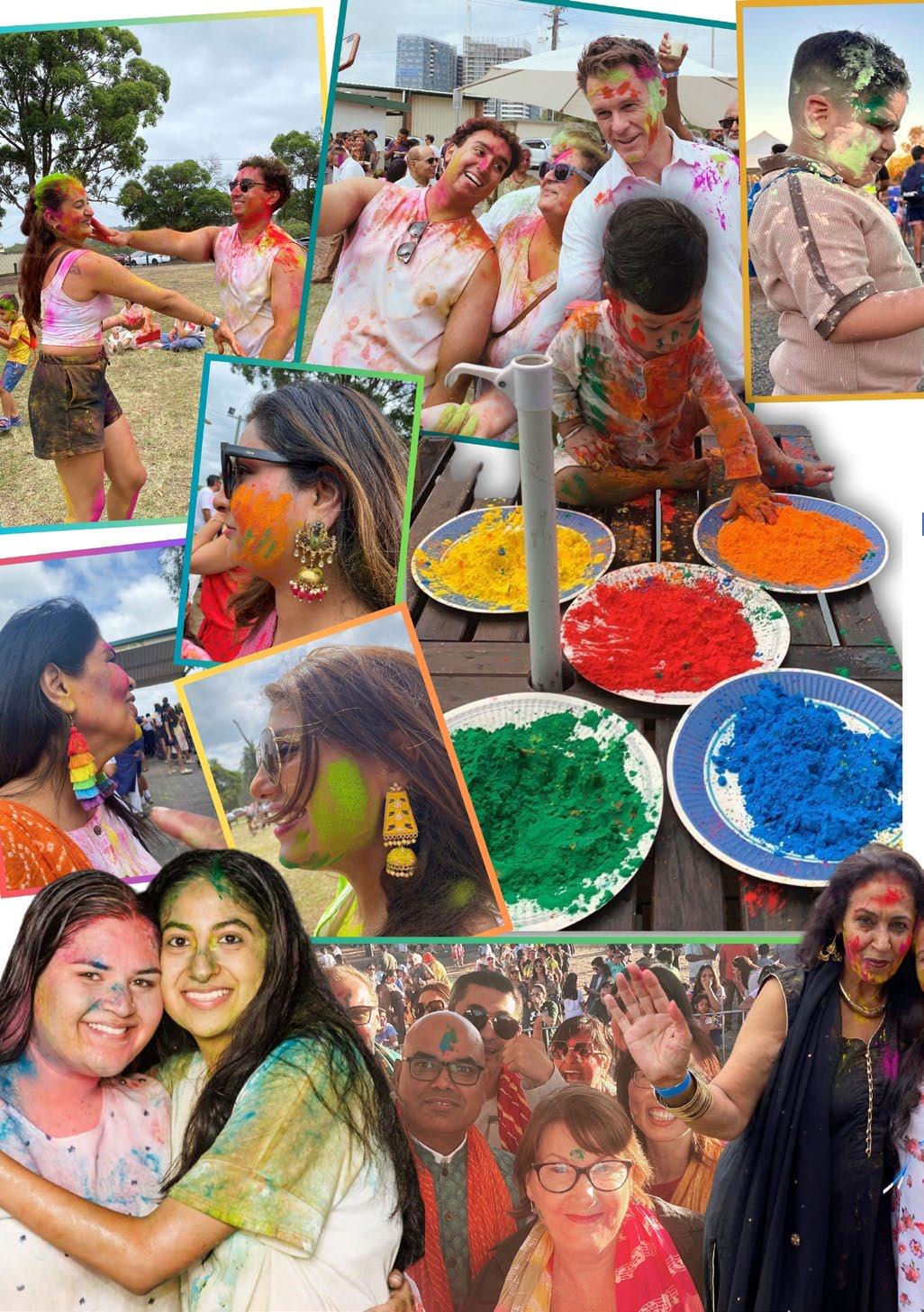
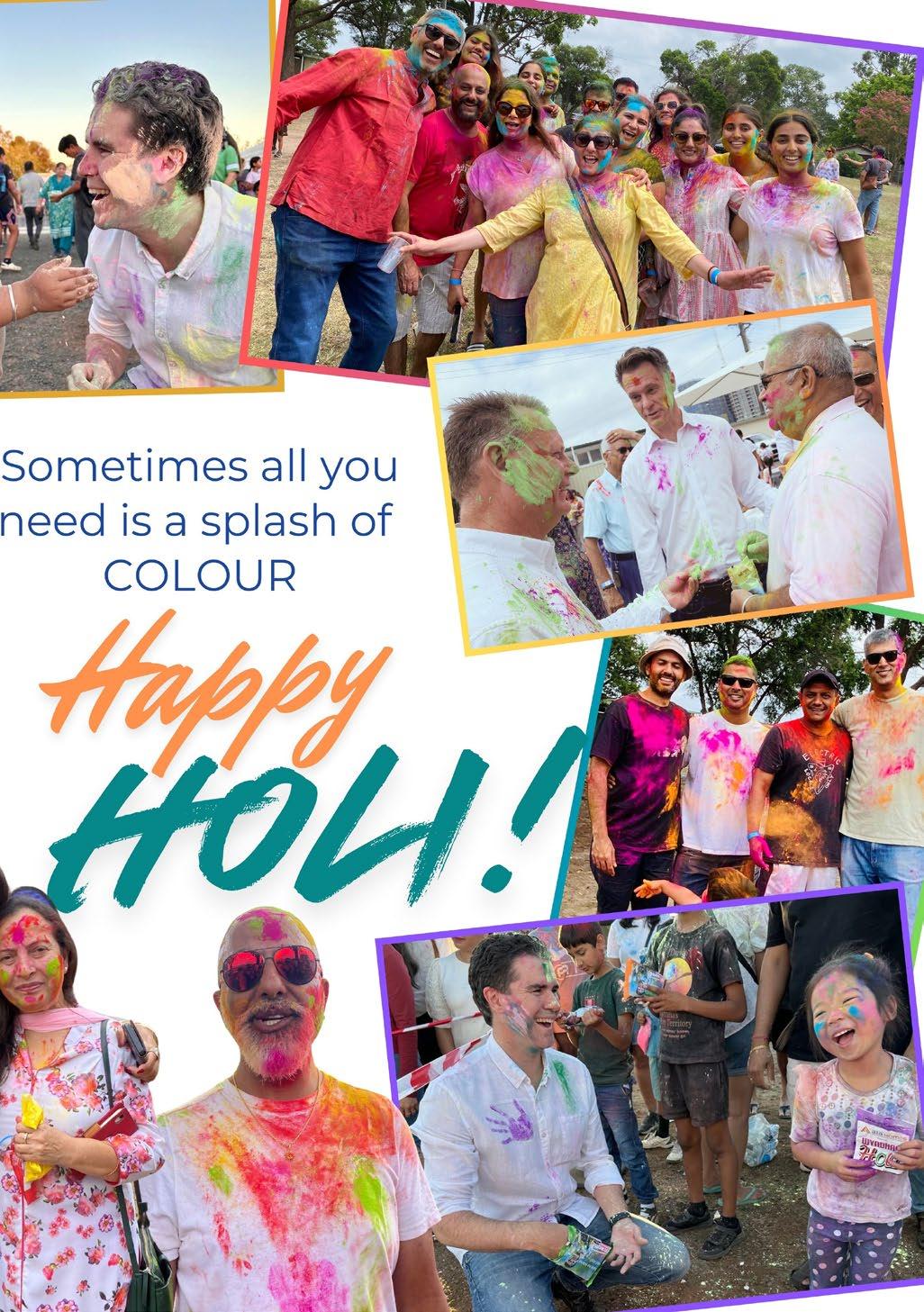
An apartment block becomes a microcosm of the country as three diverse children come together to solve a common problem
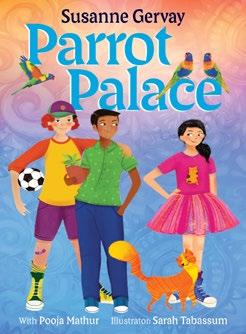

IBY SRUTHI SAJEEV
n Parrot Palace, an Indian-Australian named Hari, a Hungarian-Chinese girl named Lily-Rosa and a “dinky-di” Aussie named Mikey share a bond that gives them the courage to face their tough neighbour Mr Crabtree. Their differences give them the strength to face any challenge, big or small. This is writer Susanne Gervay OAM’s vision for young people in Australia.
This balance between delving into complex themes and creating engaging content for children is no cakewalk. And Gervay has spent much of her career trying to achieve the perfect mix. Take her highly successful series I am Jack, which delves into the impacts of bullying or The Edge of Limits which implores young men to actively stand up against overt sexual violence. Parrot Palace is another insightful addition to Gervay oeuvre of work. And the main character Hari is proving to be a fan favourite, especially within the Indian community.
“I’ve had parents tell me that their kids were excited to see someone who looked like them in the book. I think it’s really important that kids are able to see themselves reflected in stories and to feel empowered as a result,” she says emphatically.
As an educator, mother and artist, Gervay wants children to learn how to stand up for themselves through her books, and for her work to be a home away from home.
Certainly, seeing Bangladeshi illustrator Sarah Tabassum’s beautiful illustrations of Ganesha and the family shrine is a rare yet validating sight. These illustrations are immersive and essential to giving children

Author Susanne Gervay with collaborators Pooja Mathur and Sarah Tabassum
insight into the different yet overlapping worlds of the central characters.
Whilst she knew her ideas had value, the challenge for Gervay was to portray SouthEast Asian and South Asian cultures without appearing tokenistic.
“I didn’t want to hammer any values into the minds of my readers,” she says. “I engage, empathise, but I'm not Hindu. So, what I did was research. I researched a lot.”
Her previous experiences in India seep into the novel, in a way that feels subtle. She brings her understanding of Indian spirituality as well as the learnings she took away from speaking to young Indian-Australians as an educator, to illustrate what it’s like to recreate a sense of home in a country far away from your homeland.
“Everything from leaving your shoes at the front, not trampling through the house, having a shrine - these are all just some of the simple things that I wanted to show,” she says.
Holding her hand along the way was Pooja Mathur. Mathur was Gervay’s go-to for any questions regarding Indian culture, and thus monumentally influenced the book - so much so that she’s listed on the front cover.
But perhaps beyond all this, the yearning to understand one’s identity and to belong is one that Gervay is deeply familiar with. Being the child of Hungarian immigrant parents, she’s acutely aware of what it feels like to be out of place. She turned to children’s stories as a way

of escape, preferring to pretend that she was one of Enid Blyton’s Famous Five or that she was a princess in a fairytale, instead of spending long hours alone at home.
But her main motivation to write came from her father.
“It’s difficult to leave your home, you know. And he taught me all the lessons that he learned as an immigrant and I still remember them. He was the one who inspired me to deliver truths about the world through stories,” she says.
Gervay does so with great courage. Writing Parrot Palace involved a massive leap of faith on her part. She hired an illustrator who had never worked on a children’s book before, had to undertake immense research, and is delving into themes that are rarely found in children’s books.
The latter is enough to scare a traditional publisher away. But if there’s one thing that Gervay refuses to change about her work, it’s the inclusion of complex themes such as multiculturalism, consent, identity and bullying.
“I don’t tell children what to do, but I want my books to make them think and to question...I am absolutely passionate about ensuring that young people understand that we should be inclusive, to say “no” to racism and “yes” to being together. That is my agenda. And I want to get my message to the kids early on,” she emphasises.
I am Jack was previously taught in Australian schools. Perhaps it’s a matter of time until Parrot Palace appears in the school curriculum?
“I am absolutely passionate about ensuring that young people understand that we should be inclusive, to say “no” to racism and “yes” to being together. That is my agenda.”
A look at how TikTok perfected personalisation and became a cultural phenomenon

IBY SAJIT NAIR
n July 2021, the singer Gayle posted a video on her TikTok account, asking her followers for song ideas. The interaction soon turned into a fun exercise where she encouraged her followers to post comments that she could try to turn into an actual song. One follower suggested she write a song using the alphabet as lyrics. Gayle embraced this quirky idea and composed a song based on the alphabet, later posting a video of herself playing it on TikTok. That song became the wildly popular, Grammynominated ABCDEFU, which reached #1 on the Billboard Global 200.
This story neatly encapsulates the impact TikTok has had on the internet, media, and culture as a whole. Far from being just another social media platform that connects people with their friends, TikTok has become a cauldron of global content, delivered in the most personalised and psychologically persuasive way possible, so much so that it has become the blueprint for every other social media company to shamelessly imitate. It has also sparked a creative boom, allowing vast numbers of people to create authentic, unpolished, yet highly entertaining videos while building lucrative audiences for themselves. With an estimated 1.04 billion people using the app daily worldwide, including 170 million in the U.S. alone, and an average American user spending 53 minutes on it per day, TikTok has amassed unprecedented attention in an era where attention drives the economy.
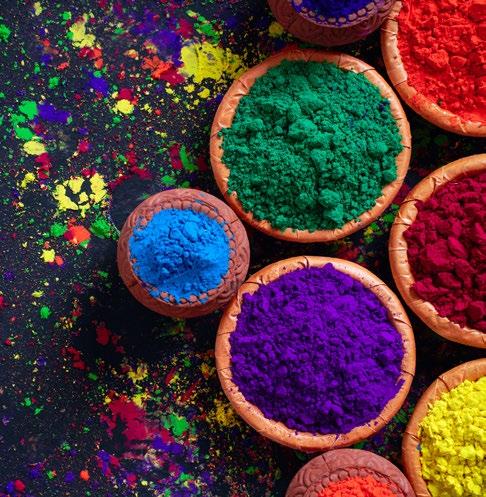


It all began in 2018 when the Chinese company ByteDance merged the popular lip-syncing app Musical.ly with Douyin, a local short - video app powered by an exceptionally effective recommendation algorithm. This merger gave birth to TikTok, combining a massive user base with a powerful algorithm designed to keep users highly engaged.
SHIFT
For those who have witnessed the evolution of social media from the days of My Space and early Facebook, it is clear how revolutionary TikTok truly is in transforming the social media experience. Before TikTok, social media was genuinely social. Every platform was designed to recommend posts and content primarily from a user’s circle of friends and connections, an approach that seemed too fundamental to challenge. The social graph was at the core of Facebook’s algorithm. TikTok completely upended this model. Instead of assuming that users wanted to see content from their connections, it started from first principles, learning users’ actual preferences by displaying a series of videos, closely monitoring watch time and interactions, and continuously refining recommendations through machine learning.
This focus on users' unconscious interactions with content organically led to what is often termed TikTok’s “dopaminedriven design.” The endless scroll, vertical video format, and short-duration clips are all engineered to encourage a dopaminedriven cycle of continuous engagement. This design has often been criticised as addictive, as the instant gratification effect
is particularly pronounced among teens and young adults, who frequently spend hours browsing content on TikTok.
TikTok’s success has been so profound that technology commentators often refer to its impact as the “TikTokization of everything.” Social media platforms across the board have mostly abandoned content recommendations based on social connections, instead adopting TikTokstyle “For You” sections. These sections mimic TikTok’s exact formula, that is, short-duration videos, endless scrolling, and engagement-driven content delivery. And yet, no other social media company has been able to replicate TikTok’s "secret sauce," which is the algorithm that keeps both its user base and creator community loyal to the platform.
TikTok has also caused a fundamental shift in user behaviour, with many users now skipping Google and turning to TikTok for advice and recommendations on travel, music, movies, and restaurants. Entire industries, such as the music industry, now rely on TikTok as their primary marketing channel for generating revenue.
There is much to learn from TikTok’s success. For innovators and builders outside the Silicon Valley ecosystem, TikTok serves as proof that technology remains a meritocratic force in determining winners and losers. While concerns about TikTok’s addictiveness are valid and warrant further scrutiny, one cannot help but admire the simplicity of its approach and the scrappiness of its beginnings that ultimately led to its massive popularity.
Facebook’s algorithm relied on the social graph, but TikTok disrupted this by prioritising user behaviour. It tracks watch time and interactions, using machine learning to refine recommendations based on actual preferences rather than connections.
Iwas 13 when my mother first noticed a few strands of grey on my head. She naturally freaked, proceeded to pluck them out, and then used several oils to stop the process. She didn’t succeed because, by the time I started work, I had enough grey that they needed to be camouflaged.
Enter the messy henna paste treatment. Mixed with coffee powder, beetroot juice and amla powder – it was prescribed for
darkening the colour. When it faded, my hair would become a ghastly mix of slate black and orange! Then I switched to hair colour thanks to the suggestions of beauty professionals. Here too, the regular salon visits, and, hiding of the roots with kajal in between sessions in case of an upcoming important event, were as painful as visits to the dentist.
Then you had rude colleagues or strangers who would pointedly stare at
the roots that showed up a week after the treatment. Colleagues even asked, ‘You have grey hair?!’ From being embarrassed to feeling ashamed to making a snarky retort, I’ve been through the gamut. Colouring hair also comes with side effects. You are, after all, dousing your hair in so much chemical goop. My hair would weigh heavily on my scalp, which, after so many years of colour, had turned pink! Then, while oiling my hair, it would hurt
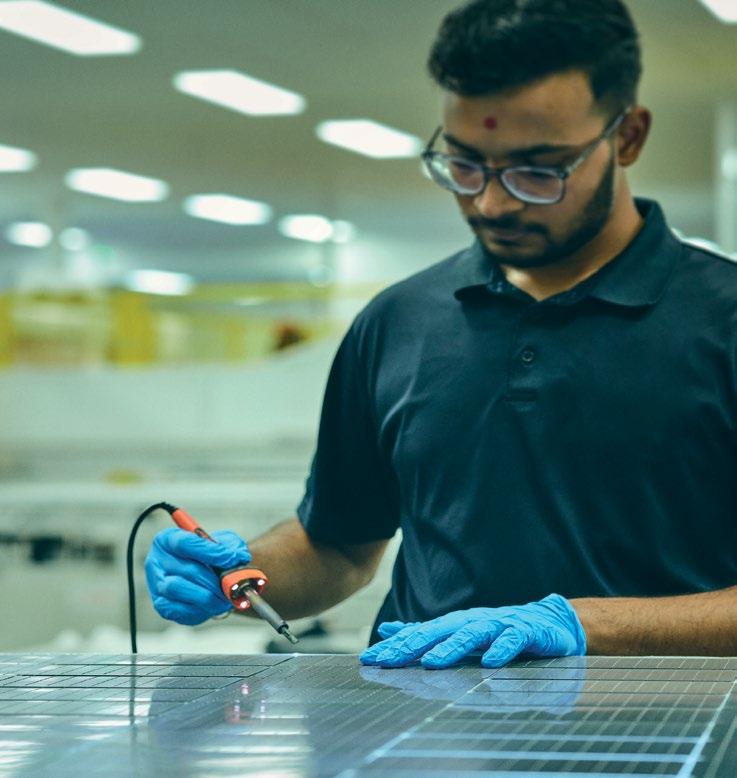
A Future Made in Australia economic plan will create more jobs and a stronger economy, by making more things right across our country. By investing in this plan today, we’re building a better future for all. That’s a Future Made in Australia.


to massage. But I soldiered on, for reasons of vanity. During the colder months, leaving hair colour on for close to an hour inevitably led to head colds and sinus problems. Severe headaches where it hurt to even bend would follow, and I would need all sorts of natural remedies to get better, fast.
Gradually, living in the city I now am in, where we get hard water in the taps, damaged my hair further. It would lie flat and lank, no matter how fancy the salon where I got it cut. I would use the high-end salon range of colour-shampooconditioner, but over time, the hair fall increased and soon, my once thick and curly hair became limp and scanty. Often, I was tempted to stop the colouring chore, but I didn’t. Then, when the hairfall didn’t stop, I decided, enough’s enough. But it was not easy. It took me a year of self-talk and psyching myself to feel confident enough to stay silver. I knew the flip side – I would look older than I am; friends ten years older than me were still colouring their hair; and, wearing certain colours or gold jewellery would be a hit and miss. After all the overthinking, I took the plunge.
I stopped colouring. Initially, the stares were awkward to deal with, so I became a headband wearer. Then, when the roots got to a decent length, my hairdresser chopped off the darker, dyed bits. After that, it was easier. People still stare, but I’m now used to it and couldn’t care less.
What was truly liberating though was the fact that I did not have to go through that long and messy process. I felt free in my head; almost as if I had taken a giant step towards self-acceptance on all fronts. It felt good to have the thickness return to my hair. They even grew faster. The only problem left was that of removing the yellow tint in the hair. Luckily, cosmetic companies are aware of the problem and there are several good shampoos now to remove the tint and keep the silver glow. What I earlier thought was a drawback – that people would think I am older than I am – has also worked to my advantage. The helping hand has been stretched out to me even though I don’t need it. Senior citizen, ha!
Embracing my greys has truly been a long, hard journey. From having low levels of confidence due to their presence, to now revelling in the silver streaks, I’ve come a long way. Hopefully, my body will forgive me for all the chemicals I forced on it all these years.
My hair certainly has.
Minal Khona


Let’s begin with your early years in Australia, and the challenges you faced as an artiste.
I arrived in Australia in 2008 as an overseas IT student from Hyderabad. Initially, breaking into the Indian Carnatic community and finding opportunities to play my violin, was quite challenging. However, joining organisations like Sydney Music Circle, and later Karpahavalli encouraged me - I was able to hone my skills and expand my network. I found the quality of musicians was/is much higher than in Hyderabad then. Of course, at the time there were also very few Carnatic violinists in Sydney. Over time, as I continued playing more concerts, I was invited to perform by many gurus and singers in Sydney and Melbourne, gradually I improved.
Tell us a bit about your musical background.
My father, a flautist, loved South Indian arts and encouraged me and my sister to pursue music. I learnt the basics of the Carnatic violin from Dwaram Satyanarayana Rao, who belonged to the Vijayanagaram tradition in Hyderabad. It was chance meeting with a friend in Sydney, Sriram Panyam, who introduced me to MA

Sundareswaran, acclaimed violinist of Parur bani style, as he believed that my skills aligned well with the Parur School of violin. I commenced learning online from Australia and learnt whenever opportunities arose during my visits to India over the years.
What has been your experience with learning music online?
Online training is feasible for advanced learners, as it focuses on theory and technique. However, it presents challenges when practicing in sync with other musicians due to lag in streaming. While it works for individual practice, ensemble training is difficult. For that, I had to sit down with local musicians to develop my ear and learn to accompany and complement them in their style and so on.
How did you get involved with composing for theatre, specifically for Shakthidharan’s awardwinning Belvoir St Theatre production Counting and Cracking?
I was introduced to theatre music through the dance guru Anandavalli, in whose productions I had played. Her son Shakthidharan who wrote Counting

KRANTHI KIRAN MUDIGONDA, a Carnatic violinist based in Sydney, is the founder of the Geervani School of Music. In this chat with SUMATHI KRISHNAN he shares his journey from accompanying musicians, to arangetrams, to composing for live theatre, and being part of the live music ensemble for Counting and Cracking.
and Cracking, sought Carnatic classical musicians to provide culturally appropriate music for the play. We collaborated with composer Stefan Gregory, who was new to Indian classical music. Initially, over two to three weeks, we held workshops, explaining ragas and classical techniques to Gregory so that he could familiarise himself to Carnatic/Tamizh culturally appropriate music. The music that was finally approved was after several samples were created. The music scored was ultimately a collaborative effort. However, the compositions remain at least about 70% improvised (Manodharma), which is also a true feature of our music.
Tell us more about the actual making of music for theatre shows, rehearsal schedules etc?
Performing live required being highly attentive to the play's flow. Since music had to compliment the dialogues without overlapping, we had to be precise with our timing. Though it was a new experience, it felt natural, as I was already used to accompanying storytelling through music for dance arangetrams and productions.
Australian theatre had specific constraints, but overall, it was a valuable learning experience.
The first season involved three weeks of full-time rehearsals, which was challenging since I was also working full-time in
IT. Subsequent seasons in the UK, the USA, Sydney and Melbourne required fewer rehearsals (about a week) since we were already familiar with the music and storyline.
In a live show, responses from the audiences are really exhilarating. Edinburgh audiences were more reserved, whereas New York audiences were open and highly expressive, reacting enthusiastically to emotional moments. Their responsiveness was encouraging, and almost every show received a standing ovation.
Why do you think Carnatic violin has not gained popularity in the West? Western violin techniques are highly structured, whereas Carnatic violin evolved with its own unique methods. It is challenging for Western violinists to adapt to Carnatic styles, as it requires a significant shift in technique. Conversely, a Carnatic violinist might find it easier to adapt to Western styles, as seen with musicians like L. Subramaniam.
Any upcoming performances you’d like to plug?
This December, I plan to perform concerts in Chennai and Hyderabad. Last year, I received grading at All India Radio, which is given only when a very high standard of playing is achieved. I might have the opportunity to play a concert there this year.
Besides his vast experience in accompanying local and visiting artists for concerts across Australia, Kiran has also been involved in various cross-genre collaborations. The award-winning play Counting and Cracking by Belvoir St Theatre was first featured at Sydney Festival 2019. Kiran has since toured the UK and USA with this production, performing at the Edinburgh International Festival, The Birmingham Rep Theatre, and the Public Theater, New York. Beyond the violin, Kiran is also trained in Mridangam and Kanjira.
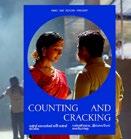



What lessons

TBY ABHISHEK GOEL
he Yamuna River, a sacred and life-giving waterbody in India, faces numerous challenges in its quest to remain pristine.
Originating from the Yamunotri Glacier in the Uttarakhand Himalayas at an altitude of 6,387 metres, the Yamuna River flows across seven states, supporting over 57 million people and accounting for more than 70% of Delhi's water supply.
As it begins its journey from the glacier, the Yamuna River is a breathtaking sight to behold. Crystal-clear waters flow gently through the picturesque valleys, surrounded by lush green forests and majestic mountains. The
river's serene beauty is a sight to behold, with its gentle currents and tranquil atmosphere.
However, as the river flows through various states, including Haryana, Uttar Pradesh, and Delhi, its pristine condition deteriorates significantly. Domestic sewage, industrial effluents, and idol immersion become major contributors to the river's pollution. By the time it reaches Delhi, the Yamuna River has transformed into a frothy, dirty waterbody, with high levels of phosphate, heavy metals, and fecal coliform bacteria.
Further damage is done in the capital.
Although only 2% of the Yamuna flows through urban Delhi, this stretch carries over 80% of the river’s pollution – its waters now dark and toxic, it takes the grim title of a ‘dead’ or ‘dying’ river.
Despite its sacred status in Hinduism, the Yamuna River continues to suffer from human neglect. Hindus worship the river as
a goddess, and its banks are often lined with devotees performing rituals and prayers. However, the contradiction between reverence and reality is stark, with the river's condition worsening over the years. Historically, rivers have been a source of conflict, with wars fought over access to water resources. In recent times, the Delhi election highlighted the importance of cleaning the Yamuna River, with the new government promising to restore the river's pristine condition within three years.
To achieve this ambitious goal, several challenges must be addressed. These include:
• Upgrading sewage treatment plants: Existing plants must be upgraded to handle the massive amounts of wastewater generated by Delhi's growing population
• Implementing effective waste management: A comprehensive waste management
system must be put in place to prevent industrial effluents and domestic waste from entering the river.
• Promoting community involvement: Educating and involving local communities in river conservation efforts can help raise awareness and drive change.
• Emulating international best practices: Studying successful river conservation projects from around the world can provide valuable insights and inspiration.
For inspiration, one can look at examples of clean and beautiful rivers around the world, including Australia:
• The Murray River: Australia's longest river, stretching over 2,530 kilometres, is a popular destination for tourists and supports a diverse range of wildlife.
• The Noosa River: Located in Queensland, this river is known for its pristine waters, sandy beaches, and vibrant marine life.
Other international examples include:
• The Rhine River: Flowing through six European countries, the Rhine River is a prime example of a well-managed and clean waterway, supporting tourism, industry, and wildlife.
• The Columbia River: Located on the USCanada border, this river is renowned for its stunning natural beauty, supporting salmon fisheries, and generating hydroelectric power.
• The fjords of Norway: Norway's majestic fjords, such as the Sognefjord and the Hardangerfjord, are a testament to the country's commitment to preserving its natural heritage.
Inspired from these rivers, perhaps these concrete steps can be taken to restore the Yamuna :
• Developing eco-tourism initiatives: Create eco-tourism initiatives to promote the Yamuna River as a tourist destination, supporting local economies and raising awareness about the river's importance.
• Establishing a river conservation authority: Set up a dedicated river conservation authority to oversee the restoration efforts, ensure coordination among stakeholders, and monitor progress.
• Investing in research and development: Support research and development initiatives to identify innovative solutions for river restoration, such as new technologies for wastewater treatment and pollution reduction.
Abhishek Goel is a Delhi-based expert on clean water management
The Yamuna originates at the Yamunotri Glacier in the Bandarpunch ranges of the Lower Himalayas. It flows down to Delhi, then on to Agra (where the majestic Taj sits on its south bank). Travelling east, it merges with the Ganges at Triveni Sangam in Prayagraj (formerly Allahabad). It then continues its course as part of the Ganga River system, and empties into the Bay of Bengal.

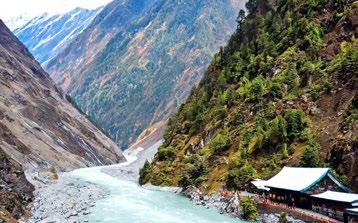


sea of humanity, a tide of awakening
Scattered leaves from PIYUSH BHATT’s Prayagraj diary, drenched in the spirit of the Maha Kumbh
February 11. We’re on the 6 am train from New Delhi, bound for the Maha Kumbh Mela at Prayagraj.
The traffic approaching the station was massive, causing a few heart palpitations, but we made it.
The Vande Bharat, India’s newest train, offers comfort with luxury reclining seats, efficient staff, and clear windows framing lush landscapes as we enjoy breakfast and the morning paper.
We arrive in Prayagraj at 12:15 pm, swept along by the crowd exiting the station. A 1.5 km walk, dodging two-wheelers, leads us to our vehicles, parked at a distance. The journey to our accommodation takes over two hours due to traffic, restrictions, and diversions.
Prayagraj is normally 1.5m people strong, and while 250m pilgrims were expected during the Mela period, the actual number will be around 530m.
Must say there’s excellent police security arrangements, though. Large sandbanks on the side of the river have all types of accommodation on them – ashram type, boarding houses, hotels.
Touching to see the faith of these millions, old and young, making their way here from all over India, travelling in most cases by foot, sleeping rough.
I’m certain some of our ancestors travelled by bullock cart and by foot to these events. My thoughts are for those millions who preceded us, from all parts of India.
I am awed by the realisation that this is an experience and a journey in the footsteps of our ancestors.
Kumbh Mela is celebrated every 12 years; the Maha Kumbh like this one, or the Great Kumbh, comes around every 144 years. It’s all dictated by the lunar


calendar Panchang – a genius planetary interpretation thousands of years old.
The Mela site this year is spread across 4000 hectares, houses 160,000 tents, 3000 kitchens and 12 km of ghats (riverfront steps). Temporary police stations have been set up for security and directions, including three anti-human trafficking units.
The economic activity generated over the period will be around the USD 23 billion mark. A vast impact.
In Prayagraj, the Ganga from the north and Yamuna from the south merge at the Sangam. A mythical third river, Saraswati, gives it the name Triveni Sangam, a sacred site for Hindus, Jains, Buddhists, and Sikhs.
At the rivers' apex stands Akbar Fort (1500s), housing temples within and a unique supine Hanuman temple outside. Each monsoon, the Ganga rises to wash over Hanuman. Today, the wait to visit is 2-3 hours. North side (i.e. Ganga side) are low hills defining the line of the river. In winter, the river is 1 km wide, with an additional 1 km of sandbank.
On the south, the sand slopes are over 2 km wide. In the rains the river is almost 5
for pedestrians. Each bridge is one-way for foot or vehicle traffic. Yesterday, we crossed one, nine deep in a single direction, passing shops, eateries, temporary lodgings, and facilities along the banks.
Pilgrims are very well behaved. Saw a few wheelchairs as well.
Met an English lady in all-Indian attire. She has a double PhD in Sanskrit and lectures here and in Varanasi.
Saw an MLA (State minister) from Rajasthan. Convoy of vehicles under police escort and hangers-on (chamchas). The material worldly visiting the spiritual wealthy – a contrast only seen in India.
We visit the Akhadas, monastic centres founded by Adi Shankaracharya in the 8th century for Sanatana Dharma. They offer pilgrim lodging, learning, and kushti (wrestling) training to defend against invaders.
We enter a Naga Akhada called Juna Akhada, one of the earliest to be set up a few hundred years ago.
Naga Babas, ash-smeared Shaivite ascetics with matted hair and minimal clothing, now often carry mobiles. Living in seclusion, they are learned; many favour hashish, hiding dilated pupils behind dark glasses. They spend long days praying and blessing pilgrims - who offer pranam, donate, and get thwacked with peacock-feathered wands! Despite their tough exterior, they have a sharp sense of humour.
At Maha Kumbh, 2-8 million pilgrims bathe at Sangam daily. We had to take a dip too. A boat brings us near the confluence, where I wade in, past flower and coconut offerings. The water is clear; I take a full dip, praying to the sun. Venturing into the Triveni, I see the distinct colours of the Ganga and Yamuna merging. Sitting on a sandbar, I watch humanity cleanse its sins. I feel a tranquil connection to ancestors who did the same generations ago - timeless yet present. I am not easily led by religious fervour, and am here out of curiosity. Yet it is hard not to feel something profound with the millions of faithful participating. The artis and chanting can be heard from miles around, like an airport roar. What an experience.
km wide, covering these sandbanks. Since it is winter now, the sands are compacted.
Most tent cities are on the south bank, broken into multiple sectors and different budgets. Ours has 200 tents. We are in Sector 25. Lots of NRIs. Our tent F282 is a ‘family’ tent, with an outer covered area with easy chairs and tables, larger living area, and a smaller section for toilet. All separated by blinds. Mosquito nets in the bedrooms.
Smaller roads in the tent city have choir runners. Wet areas have floorboards.
All these temporary structures will come down in March or April to be repurposed.
Huge communal dining area. Lots of food choice, all veg of course. Catering at our “Kumbh village” is by Taj Hotels Varanasi. Warm days. 29 degrees daytime, and cooler at 7 - 11 degrees at night, so not bad. Windy some days. The winds occasionally pick up the fine river sand and blanket the surrounds, like rough talcum powder.
Authorities have built three parallel roads along the river for vehicles and 30 temporary pontoons, mostly
Massive medical camps are set up by top Indian and international teams from Germany, Canada, and Russia. Sadly, a stampede at New Delhi railway station left 18 dead as crowds rushed between platforms. Yet, with 530 million pilgrims, casualties remain minimal. The State and Central Governments have done an outstanding job managing infrastructure for this historic gathering.
Heading back now, we hit gridlock en route to Prayagraj station. Our only option—a two-wheeler pillion ride with luggage on our laps. Larger bags need a second scooter. The two-hour journey winds through narrow gullies. At the station, a oneway foot traffic system means over an hour of walking with luggage. At one tricky spot, a human pile-up is possible, but security is present. The overcrowded platform is chaotic, with special trains departing nationwide. In the melee, it’s touch and go with our bags, but we make it through safely!
Flying back tomorrow, February 18, to a quiet, deserted town called Sydney, millions of miles from here.




exorcises its demons to win its first ICC ODI trophy in twelve years

ABY KRISHNA NEELAMRAJU
fter a painful wait of twelve years, India ended its ODI title drought with its triumph at the ICC Champions Trophy in Dubai. As the team donned its White champion jackets, the champagne must have tasted extra special, coming after the agonising heartbreak of the loss to Australia at the 2023 ODI Finals at home. The wounds of that night at the Narendra Modi Stadium are healing, and those demons were buried in the warm desert sands of Dubai this time around. India is in love with ODI cricket once again.
The Indian team won the night through a delicious mixture of youth and experience. Batting first, New Zealand were brilliant in parts but did not control the game long enough to spoil India’s party. The subpar score of 251-7 had Daryl Mitchell top scoring at 63. Mohammed Shami ensured Mitchell did not repeat his 2023 World Cup heroics against India, when he almost took the semi-finals away with a scintillating century. Michael Bracewell (53*) accelerated the scoring in the last 5 overs to ensure his team crossed the 250-run mark. Spinners Kuldeep Yadav (2/40) and Varun Chakravarthy (2/45) were the standout bowlers for India, serving a masterful blend of flight and deception to control the scoring and picking wickets at critical moments in the game. The old Gods of spin would have been pleased at the artistry displayed by the duo. Jadeja too proved his worth with an astounding 3.00
run rate in his 10-over spell and snaring Tom Latham plumb in front of the wickets. India’s reply started strongly with an oldschool pull for a six by Rohit Sharma (76) on the very second ball. It was a classic, unhurried Sharma innings peppered with 3 sixers and 7 fours, resembling a seasoned emperor cruising to the end of his reign, well aware of the legacy he’s setting. Shubman Gill (31) and Sharma put together a 105-run stand for the opening wicket, effectively shutting the door on a New Zealand victory. Indian cricket fans of little faith would have experienced a familiar sinking feeling when the team lost Gill, Virat Kohli and Sharma’s wickets for 17 runs mid innings. They needn’t have worried, as
the talented middle order ensured a fairly smooth march to victory after that. In fact, India’s win probability on various cricket websites never dipped below 60% after the first over.
The tournament had its share of controversy about India’s “single ground” advantage. New Zealand travelled 7,048 kilometres throughout the tournament, more than twice as much as any other team and played 5 matches at 4 different venues. In contrast, India played all its games at Dubai and in front of mostly Indian crowds after the Modi Government refused to send its team to the official host nation Pakistan. The luxury of
not having to pack their bags every few days and playing at the same ground, arguably gave the team an advantage, especially to the spin bowlers. In 2011, former Captain and Coach Rahul Dravid commended BCCI for leveraging its financial and political influence to provide the team with advantageous conditions after decades of condescension. BCCI is way more powerful now than in 2011, to the point of shifting the tournament’s centre of gravity to Dubai, overshadowing Pakistan’s role as the host nation.
As the Indian fans celebrated victory, questions remain about the future of three of its ageing greats – Sharma (37y), Kohli (36y) and Jadeja (36y) – who dominated the team’s ODI cricket history in the past decade and a half. Sharma has been one of the most destructive openers in ODI history with his record-breaking three double centuries. Kohli is the most dominant batter of his generation, with 50 centuries to his name and 13,000+ ODI runs. Jadeja’s heroics often get shadowed by the mindblowing numbers of the top order batters, but celebrated no less by the Indian fans. His all-round brilliance has ensured balance and depth in the team over the years. Time marches on, however, and the selectors have to assemble a team for the future, even as Sharma declares he has no thoughts of retirement yet. The likes of Yashasvi Jaiswal, Tilak Verma and Ruturaj Gaikwad need to be given adequate experience on the green to carry the team forward. Gill looks eager to step out from his role as an understudy for leadership in all formats. Verma, above all, is more than ready for the grand stage. While the torches of triumph are still ablaze and the greats stand victorious in the twilight of their careers, they will be aware of the need to renew the cycle and pass on the mantle. As the cliché goes, timing is everything in cricket.
This win is a moment of collective relief for Indian fans and a chance to celebrate the return to ODI dominance. After the IPL and T20 took over, the country began falling out of love with the ODI format. This victory in Dubai has rekindled its love and restored its faith in the team. Tales of this victory will be told with pride for years to come in India’s grandest theatre of cricket.
































BY GAURAV MASAND
Eat, play, celebrate! With these festive bites and colourful delights, you’ll bring back childhood memories – and make new ones with family and friends. Our gourmet goodies this Holi blend tradition with modernity. From rich chocolate, refreshing frozen desserts, to classic Mathura street treats, these next-level noms will have you craving more with every colourful bite.


With its aromatic blend of spices, a glass of thandai break from the day’s playful chaos with its cool and creamy texture.
Ingredients
n 1/2 tbsp fennel seeds
n 1/2 tbsp poppy seeds (
n 1/2 inch piece cinnamon 1/2 tsp nutmeg powder 4-5 white peppercorns (optional)





n 1/2 tsp cardamom powder
n 1/4 cup almonds
n 1/4 cup cashews
n 2 tbsp pistachios

n 2 tbsp rose petals
Instructions
n Toast the spices in a pan and let them cool. Then grind to a powder.




Separately, grind the nuts with rose Mix both the nut and spice powders, and grind again. Store in an airtight


1 litre milk (full cream or skim milk)
Method
n Mix saffron and sugar into milk and bring to a boil. Cool, then chill in refrigerator.
n When ready to serve, add the thandai powder to the chilled milk. Use 3-4 tbs of thandai powder per litre of milk.
n Serve immediately.
n (Serves 4)

Mathri (or biscuit that always conjures up childhood memories of afternoon teas, both summer and wintertime. When Mum served it with a tangy chai, it was a simple, earthy pleasure! It is typically deep-fried but I’ve learnt how to use the air fryer for a healthier version –the results are pretty close to the original.
Ingredients
n 3/4 cup
n 1 tsp salt
n 1/2 cup water to knead

n 1/2 cup fresh finely chopped
n 2 tbsp oil

n 1/4 cup oat flour (or plain flour or whole meal flour





n Add the oil to plain flour, oat flour and salt. Mix well to combine.



n Knead a medium tight dough by adding all ingredients.
n Take a small amount of dough and roll it into a big flatbread using a rolling pin. Use a cookie cutter to cut out circles or any desired shape.

n Preheat the air fryer for 10 mins at 170 deg C.
n Place the in the basket. Cook for 12-13 mins at 170 deg C. Spray oil once and flip so that it is cooked evenly on all sides and is golden brown.





n Cool and store in a clean dry jar.




Chocolate and j


Ingredients
n 3 cup chocolate chips
n 1/4 tbsp coconut oil n 125 gms


This is simply delightful as a Holi treat, featuring melted chocolate, crunchy and nuts for a delightful mix of textures and flavours. For this recipe, I’ve used an air fryer/oven, but you can also use a microwave to cook the chocolate chips in microwave-safe bowls.

This traditional sweet from Mathura, the ultimate Holi hub, is made with slowly cooked mawa, jaggery, and aromatic spices, creating a melt-in-yourmouth experience ideal for celebrations.




Ingredients
n 1 cup mawa/khoya (for quick recipe, see below)
n 1/3 cup powdered jaggery (preferably of the Kolhapur variety, or any other type light brown in colour)
n 2 tbsp milk



n 1/4 tsp cardamom powder
n 1/8 tsp nutmeg powder
n 1/8 tsp cinnamon powder
n 1/2 tsp powdered pistachios (optional, for garnishing)
n 1 1/2 tbsp ghee
Method



mawa.


n Either crumble or grate the

n In a non-stick pan over medium heat, add the mawa.
n Mix with a spatula, and while doing so, slowly add ghee over 5-7 minutes.


n The mawa will begin to turn brown.
n Next, incorporate jaggery into the mawa, then add the spices and milk.
n Keep scraping and folding the mixture along the sides of the pan to create a smooth, consistent texture.

n Continue to mix until the ghee separates or the mixture looks shiny.
n Set it aside on parchment paper for 10 minutes.
n Begin shaping the warm mixture into small balls.
(Optional) Garnish with powdered pistachios.







Put the chocolate chips and coconut oil in a bowl that’s safe for the air fryer or Preheat your air fryer to 150C|300F for 5 minutes. Before air frying, cover the bowl with aluminium foil. In case you’re using a microwave, do not use the foil:
n How to make mawa: Melt 2 tbsp ghee, add ½ cup







cook for 2 minutes, then mix and again cook for a further 1-2 minutes until the chocolate is melted.


Air fry for 9–10 minutes at 150°C/300°F, then remove the foil and Using baking paper, spread the melted mixture on a baking sheet. jalebi, nuts, and rose petals. Refrigerate for about an hour, then break into as many pieces as you’d like. Keep refrigerated until serving; it melts quickly at room temperature.


Here’s a refreshing twist on the classic ice cream infused with betel leaves for a unique aromatic dessert to cool down your Holi celebration.
Ingredients
n 1 cup full fat milk
n 1/2 tbsp fennel seeds
n 3 paan
n 2 tbsp rose water
n 1 tbsp coconut flour /very finely desiccated coconut
n 1/2 ltr vanilla ice cream
n For garnish: Cherries and 2 tbsp desiccated coconut





mix with milk and rose water. Let it
reduced to half the original quantity. Incorporate the coconut flour and






BY APOORVA TANDON
So you’ve been to the Ramadan night markets and loved what’s on offer. It’s time then to check out Iftar (evening meal) offerings at the restaurants. Mansaf lamb. Mashawi. Haleem. KaftaMishwe. Nihari. Shish Tawook. Mouth-watering delights from the Arab world and South and South East Asia. Or seafood, steak or burgers if you prefer! Here’s our list of the top spots in Sydney and Melbourne to join the Muslim community as they break their fast. Worth checking if these restaurants also offer a morning meal takeaway Sehri!
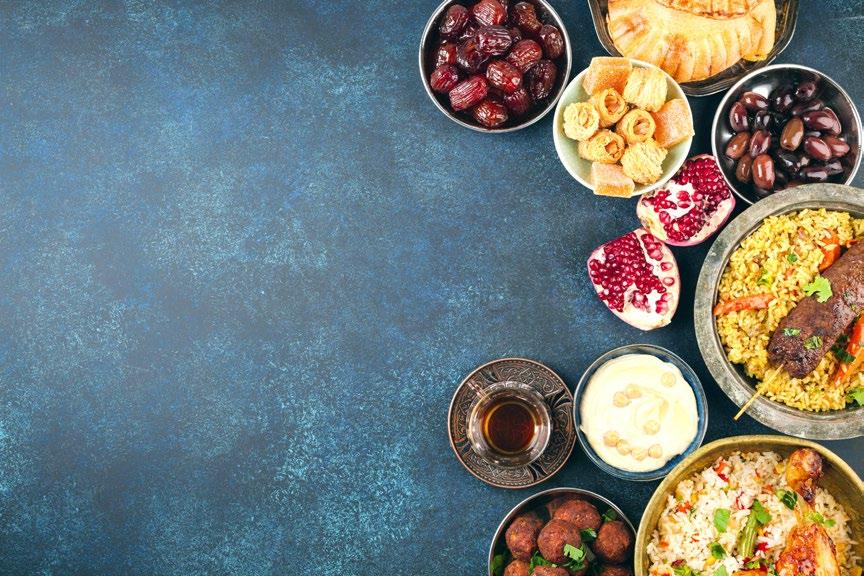
1. Al Aseel (multiple locations)
Renowned for its authentic Middle Eastern cuisine, Al Aseel offers a mouthwatering Iftar spread at ten locations across Sydney. It’s the perfect place to indulge in classics like Kafta Mishwe and Shish Tawook. They also offer a daily special to keep things interesting.
2. Monsoon Palace (Auburn) This one’s a hidden gem for buffet lovers. Their Ramadan Iftar Special Buffet boasts over 25 dishes, offering
3. Lal Qila Darling Harbour (Darling Harbour) You’ll find Lal Qila’s renowned Iftar buffets on any list of Ramadan favourites. It’s the welcoming atmosphere, regulars will tell you, on top of the vast array of traditional Pakistani and northern Indian cuisine. Book to ensure availability. Prices for Mon-Thur Under 4: free | 4 – 10 : $34.99
4. Titanic Café (Bankstown) Titanic Cafe is a must-visit if you’re around Bankstown. Enjoy rich flavours and traditional favourites like Mansaf lamb and Mashawi in their hearty buffet. A great spot for family and friends to gather.
Price per person: $65 For kids under 12: $30
5. Armani Restaurant (Parramatta)
Looking for a mix of international flavours with a touch of Middle Eastern flair? Armani Restaurant brings together seafood, steaks, chicken, pastas, and risottos, offering something for everyone.
Price per person: $90 For kids: $50
6. Volcano’s Steakhouse (Bankstown)
Head over to Volcano’s Steakhouse for a popular buffet that includes everything from ribs and grilled sirloin to squid. It’s a feast that’ll satisfy everyone at the table.
Price per person: $79.90
Kids (4-10): $39.90 Kids under 3: Free
7. Sultan Palace (Glebe)
For a delicious desi feast, Sultan Palace in Glebe offers a fantastic spread featuring authentic Pakistani dishes. Bookings are essential, so plan ahead.
Price per person: $35
Kids (4-10): $20
Kids under 3: Free
8. Mehfil (Auburn)
If you’re craving a mix of Hyderabadi and Arabian flavours, Mehfil’s all-you-can-eat buffet is the way to go. Available from Iftar until it’s all gone, you won’t leave hungry!
Price per person: $27.99
Kids (6-14): $18
Kids under 5: Free
9. Maharaja Karahi (Padstow)
Maharaja Karahi offers a buffet filled with authentic Pakistani dishes like Haleem and Nihari. If you’re on the go, grab a takeaway box to enjoy anywhere.
Price per person: $35.99
Kids (3-10): $17.99
10. Rashays (multiple locations)
With eight locations across Sydney, Rashays’ special buffet menu includes ribs, burgers, pastas, and grills – a great spot to break your fast with loved ones.
Price per person: $49.95
Kids (4-10): $19.95
Kids under 3: Free
Other Sydney spots worth checking out: Feast in the Middle East (Granville), Hyderabad House (Harris Park), Faheem Fast Food (South Strathfield & Enmore), Sizzlingo (Padstow), Do Darya (Bexley)
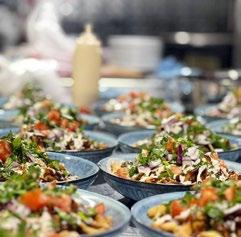
1. BBQ Lounge (Brunswick and Westmeadows)
BBQ Lounge brings a hearty spread with kebabs, assorted breads, Nihari, Biryani, and more. Both branches serve special Iftar and Eid feasts.
Price per person: $49.99
Kids (5-10): $26.99
2. Ziyka (Carlton and Broadmeadows)
Serving a buffet with over 25 dishes, Ziyka is your destination for a memorable Iftar feast. They also offer a special Sehri buffet.
Price per person: $40
3. Karachi Street Food (West Meadows) Craving comforting home-cooked desi flavours? Karachi Street Food offers both Sehri and Iftar buffets, with dedicated prayer spaces to enhance your Ramadan experience.
Price per person (Mon-Thurs): $39.99
Kids (5-10): $25.99
Price per person (Fri-Sun): $41.99
Kids (5-10): $21.99
4. Arabesque (CBD)
Known for its all-you-can-eat Ramadan buffet, Arabesque serves up everything from Kabsa and Mandi to grilled skewers and traditional desserts.
Price per person: $55
5. Mint & Co (Carlton) It’s Dubai, right here in Melbourne, at Mint & Co. Their huge Iftar buffet runs weekdays, capturing the true spirit of Ramadan.
Price per person: $49
6. Burgertory
Who doesn’t love a good burger? Burgertory (multiple locations) offers meal deals perfect for Iftar, with each combo including a date, burger, fries, and drink. Meal for 1: $17
Meal for 2: $32
7. Lazzat Kaddah (Coburg)
Lazzat Kaddah’s Iftar buffet (Wednesday to Sunday) offers a range of authentic dishes, with takeaway options available early in the evening. The buffet opens for ladies and children first, followed by men. Menu changes daily.
Price per person (Adults): $50 Kids (3-12): $25 Kids under 3: Free
8. Fawkner Kebab House (Fawkner) It’s Pakistani cuisine that is the mainstay in the Iftar buffets at this Pakistani-Turkish restaurant. A popular specialty – matka curd! It’s open for both evening and morning meals, and also provides takeaway boxes –all reasonably priced.
Prices: Iftari: $35 per person, ($20 for kids), 5.00 – 9.00 pm daily Sehri: $25 per person ($17 for kids), starts 2.30 am daily Iftar box takeaway: $18
9. Leyalina (Carlton)
Looking for something different? Try Egyptian. There’s a Ramadan special banquet, or choose from the à la carte menu with options such as Kebda eskandrany, Hawawshy “Araies”, lamb cutlets, Moza dunney, Roz moammar, and more.



Jissa Jose’s feminist masterpiece Mudritha was released in 2021, and whilst that makes the English translation of the work four years too late, it now finally stands a chance of being recognised globally. Set in contemporary Kerala, this award-winning novel is a story of women coming into their own. It may sound like heavy reading, but it’s wrapped in the gloss of a mystery novel as it follows the story of a tenacious police officer unwilling to give up a case of nine missing women. Sounds like something that ought to be prescribed reading for all!

Anoushka Shankar once again proves her virtuosity in channelling both the East and West in her music through her latest album Chapter III: We Return to Light. Her singles are stunning in their simplicity, much like your favourite movie soundtracks. If you’re a filmy person, then you’ll feel compelled to construct detailed storylines to complement your listening experience. Releases like Hiraeth contain equal parts light and darkness, making for a dynamic listen. It's a must even for those who aren't familiar with Shankar's musicality. Who knows, maybe a March favourite could turn into a lifelong fave?

If a film has the capacity to potentially break your heart (though, the writers thankfully restrain from doing so), then you can be sure that it contains joy in equal parts. In Anuja, this joy is deeply embedded in the relationship between the two sisters at the heart of the story as they navigate a life of poverty. It features standout performances by Ananya Shanbhag and Sajda Pathan, who was a child labourer herself and unflinchingly immerses herself in her role. It may have missed out on an Oscar, but it definitely deserves a spot on your movie list.

Looking for an Indian twist to a classic drink? Gulkand (rose petal preserve) might be that missing ingredient. Not only is it a cure-all (it can reduce acidity, help improve your skin, reduce inflammation, the list goes on), but it turns out that it can truly elevate a classic mojito. Just imagine the sweetness of gulkand combined with the minty flavours of a typical mocktail. It’s a tantalising, surprising and refined drink and will leave your guests wondering what the secret ingredient is …as long as you don’t tell them where you got the idea from!
WRITTEN BY SRUTHI SAJEEV

Tips for choosing a group tour that's right for you, from a professional tour guide

TBY PETRA O'NEILL
here are many benefits to group tours - your transport, accommodation, sightseeing and meals are taken care of, you'll have a tour leader to handle logistics, leaving you free to relax, and the cost may well be less than going it alone.
Your enjoyment of a group tour though will be influenced by doing some research beforehand. Here's how you can get the right fit for you.
Research the destination you are wanting to visit and note down all the places you’d like to see. Then select those tour operators that go there and narrow your choice down to those that will go to all or most of the places and sites you have chosen as important. Consider the depth of coverage for each destination, for example avoid itineraries that only drive by sites pausing for a photo stop, and spend only one night before moving on, since the time is inadequate to appreciate and absorb the place being visited. An itinerary that covers a lot might look great, but if you want to immerse
yourself rather than skimming the surface, you'll need at least two nights. Look for slower paced journeys that feature fewer stopovers, and double nights in the same hotel, with access to places that would not be open to you otherwise. Also consider the tour operator's rating and expertise in running tours to the destination, to ensure they run the tour and will provide the back up if anything goes wrong, rather than outsourcing it.
Note down what's important to you, from a focus on culture, outdoor activities such as hiking, luxury hotels, fine dining, and then seek out tour operators that offer a travel style that matches your interests. Then consider getting the balance right between group tours that include all sightseeing, to those that offer more flexibility, such as optional tours, and free time to self-explore.


Consider the experiences the tour will offer such as whether cultural activities are included and the opportunity to meet with locals to learn of their culture. And if hikes and physical activities are included, but some in the group are unable to do them, is an option available, such as remaining on the coach? On a group tour in Jordan once, a focus of the tour was hiking. As several on the tour were unable to hike, the tour leader modified the itinerary and instead took us to a lookout.
Consider too how you will experience an attraction. By comparing itineraries, for my upcoming tour to Chitwan National Park in Nepal, Intrepid provided the most comprehensive coverage with a canoe trip, a jeep ride, optional early risers bird watching tour, and village visit, with two full days spent at the park. If a destination is important to you, ensure you get good coverage.
When it comes to hotels, find out where you'll be staying at each location, avoiding those that are not centrally located or at a distance from the destination's main attraction, such as a beach. Then consult a travel site with reviews of the hotels to see that the standard suits you. Also ask the tour operator if the hotels will be subject
to any major work that could impact your stay. I didn't ask, and on a group tour to Jordan, three hotels were undergoing major renovation, were not centrally located, and the pool at one was closed for maintenance.
Note the meals that are included, since buying your own will add to the cost of your trip. But while it's tempting to book a group tour that covers all meals, unless it's a camping trip where options aren't available, this isn't ideal. Group meals take a good chunk out of the day, your meal choices will be limited, are generally taken at your hotel, or restaurant that caters to tour groups, and you'll be dining with the same people over and over. Consider tour operators that provide immersive experiences such as visiting local restaurants, or vineyards. Food is a big part of the cultural experience, so try to get out to experience street food and places where locals dine during your free time. If you have a special diet, ask what you will be given to ensure you will have a suitable substitute.


Your trip's highlights will be magnified when experiences are shared, and your fellow travellers will offer companionship, especially important for solo travellers. You will be together with your tour group for large chunks of each day, so it's important that they are compatible. Attend briefings and travel talks and consider the type of traveller used in the company's advertising, since they represent their target market. Ask the tour operator about several departure dates and who is booked on the tour, whether solos or couples, and what the age profile is. Check the activity level, to ensure it matches your level of fitness.
If you are a solo traveller, you will be better suited to a tour with other solo travellers. Solos either pay a single supplement or choose to share a room. If you do opt to share, pack ear plugs and an eye mask and set ground rules early on. Agree on times for sleep, showering, waking and packing. Negotiate your priorities, give each other space, and if you struggle, let your leader know.
As a tour guide, my experience has been that a minority in the group will demand more than their fair share, expecting preferential treatment, and they are endlessly dissatisfied. My advice is to avoid those who will dampen your spirits and engage with those with an interest in the journey. If you have an issue, refer it to your tour leader, but within reason. I was once woken after midnight by a guest who wanted a fluffier pillow!
Establish what's covered in the cost. Some group tours include all sightseeing, others offer optional excursions at an additional cost. Choose the optional tours you'll be taking and add that on. Free time with fewer meals provided, will also add to the cost, so estimate the cost of meals. Book ahead to lock in the price and monitor when sales are offered and consider departures during the off season. Packages that bundle the land and air components may be cheaper than booking flights independently, though it pays to do your research. My friend Jacqui booked a group tour to Taiwan, with airfares included, though flew via Kuala Lumpur with a lengthy layover. Tour operators may also offer to book your flights, though this may be more expensive. Again, do your research, it may be preferable to book your own flights and choose your preferred airline.
Group size is an important consideration in choosing a group tour. Larger groups generally mean lower cost, but anything over
20 will result in more time spent waiting to check in at hotels, standing in queues to enter sites, loading bags and getting on and off the coach, longer toilet stops, and less time given to you by your tour leader. The ideal number in my view is around 18. Too small and there might not be enough like minded travellers, so again, ask the tour operator for the numbers booked for several departure dates. On a tour of Egypt, the group was too small, with only 6, and that was a challenge.
This role is crucial to your enjoyment. All logistics will be taken care of, all problems rectified to ensure a smooth journey, special diets catered for, and often with the assistance of a local guide, expert and insightful commentary to provide you with a deeper understanding of the places being visited, than if you visited alone.
Your tour director works long hours reconfirming the arrangements while on tour. If you have issues, allow them time to resolve them, and don't overload them with too many requests, or issues that they can't fix. And don't forget to tip the tour leader, driver and local guides.
Group tours do involve inevitable regimentation and predictability, times are scheduled for each day, involving early starts, and you may not be interested in everything you see. Most tour leaders are good, though I did hear one say: "There were no skyscrapers when Sydney was first settled."
I also consider a tour operator's mission statement, to determine whether they share the same values, that would include supporting programs to form connections with local communities, travelling in an ethical manner, and being environmentally aware, to ensure I'll be undertaking a group tour compatible with how I would travel.

KHUSHEE GUPTA is bingeing her way through a diverse line-up across multiple languages and genres - action, romance, thriller and horror
MY MELBOURNE (In cinemas)
An anthology film featuring stories of multiculturalism and identity, My Melbourne presents heartfelt tales of Indian-Australians navigating life and belonging. Four stories directed by Kabir Khan, Imtiaz Ali, Arif Ali and Rima Das, the film premiered at the IFFM last year.
Releasing 6 March

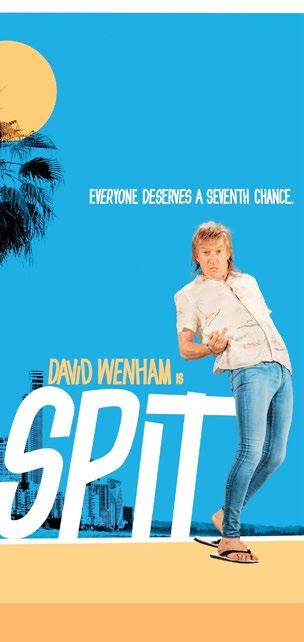
SPIT (In cinemas)
The iconic Aussie ex-con is back, and he hasn’t changed one bit. This comedy starring David Wenham, Pallavi Sharda and Arlo Green, is filled with runaway Johnny Spiteri’s usual antics as he returns to Australia and comes face to face with old enemies.
Releasing 6 March
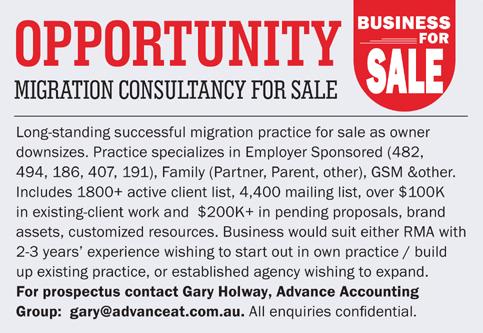
PICTURE THIS (Amazon Prime)
It’s the rom-com everyone’s been talking about, starring none other than South Asian “it girl” Simone Ashley. Following the classic enemies-tolovers story arc, it is a must for romance fanatics looking for their next obsession.
Releasing 6 March




NADAANIYAAN (Netflix)
A fresh pairing in Khushi Kapoor and debutante Ibrahim Ali Khan in a high-school romance, exploring relationships, misunderstandings, and heartfelt family moments.
Releasing 7 March

KINGSTON (In cinemas)
India’s first sea fantasy adventure film, this is a Tamil film that brings a visually stunning narrative filled with mythical creatures, oceanic mysteries, and a gripping storyline.
Releasing 7 March

THE WAKING OF A NATION (Sony LIV)
Inspired by true events, this series follows a young lawyer fighting to prove the Jallianwala Bagh massacre was a conspiracy, featuring Taaruk Raina and Nikita Dutta in key roles.
Releasing 7 March

DUPAHIYA (Prime Video)
This gripping drama follows the journey of a village as it celebrates its 25th anniversary of being crime-free when a prized motorbike vanishes. Starring Gajraj Rao, the film follows the frantic search before all is lost.
Releasing 7 March

John Abraham’s political drama navigates the world of international relations as he tries to extradite an Indian girl from Pakistan, where she was forced into marrying against her will.
Releasing 14 March

Starring Abhishek Bachchan, this heartfelt drama follows a single father’s journey to support his daughter’s dream of performing on a national dance reality show.
Releasing 14 March
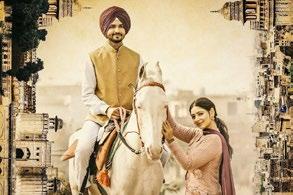
A gripping Punjabi drama, this is a moving love story set in rural Punjab, where tradition, aspirations, and personal choices intertwine in unforeseen ways.
Releasing 14 March

SIX EACH (In cinemas)
Starring Mandy Takhar, this Punjabi film follows the story of a Canadian student facing charges in her husband’s death after allegedly deceiving him for visa purposes.
Releasing 14 March

KESARI VEER (In cinemas)
A historical action drama on the war against religion featuring Suniel Shetty, Sooraj Pancholi and Vivek Oberoi. It showcases the life of an unsung warrior Hamirji Gohil and is packed with patriotic fervour, intense battle sequences, and compelling storytelling.
Releasing 14 March

TUMKO MERI KASAM (In cinemas)
The film follows the life of Dr. Ajay Murdia, the founder of the nationwide chain of fertility clinics Indira IVF, as he navigates the challenges of building a medical empire while finding love.
Releasing 21 March

L2: EMPURAAN (In cinemas)
The sequel to Lucifer, this Malayalam-language action thriller directed by Prithviraj Sukumaran continues the high-stakes political drama with Mohanlal in the lead role.
Releasing 27 March

HARI HARA VEERA MALLU: PART 1 (In cinemas)
A Telugu-language historical action adventure starring Pawan Kalyan, Bobby Deol, and Nargis Fakhri. The film dives into the legendary tale of a rebellious warrior.
Releasing 28 March

Minal Khona has been reading tarot cards for the last two decades. She uses her intuition and connect with the cards mostly to help people.
A month to look at what needs to heal within. An ace card is drawn for you, which stands for beginnings, so expect a new start. Singles could get engaged, couples could have a baby, work becomes more positive. Creativity is available in heaps and so are new ideas. An excellent month healthwise, and you can expect a pleasant surprise. A new contract or project will add to your income. Your new ideas will give you excellent results. Go ahead with confidence and happiness.
Expect the unexpected in love and other relationships. Walking away from a break-up won’t be so easy. A rocky relationship won’t break despite its challenges. Or again, an ex could make a comeback into your life. Stay calm in the face of upsetting events. Finances need attention. A new sense of direction in your work or personal life is foretold. If you are currently feeling trapped, it is a temporary thing, and things will change for the better soon.
A difficult month as setbacks in business and heartache in personal relationships could affect you. Singles will be unwilling to trust again. Some of you may hear from someone quite unexpectedly – a pleasant surprise. Paperwork will cause problems, so be careful. If going through a low phase emotionally, don’t lose heart, things will get better soon. Take a break from work and stress. Money held up will come to you. Any delays at work will be to your advantage. Avoid impulsive actions.
You picked the card for Aquarius –meaning, the July born could be less moody this month. Letting go of the past in a relationship will give you relief. Don’t get so defensive in difficult situations that you are blind to others’ feelings. A patch-up with an old friend is on the cards. Be cautious while driving. Discussions with family about money and relationships could cause disharmony. Clarity about your life will make you want to sort your life out.
Clarity is your code for March as it is imperative to take the rose-tinted glasses off. What illusions are you harbouring about others that need to go? A good way to do so is to be less emotional and more practical. You quell loneliness with work that is also unsatisfying. The self-employed will see business get better. Expect insight into a situation that was bothering you. A debt will be paid back to you. Practice gratitude and count your blessings.
You pick the card for Leo, meaning the finicky Virgo becomes a little outgoing and generous. Singles will meet someone interesting, and it could lead to an affair. Expect a boost in your business and a promotion at a job. A difficult relationship could end as you choose to walk away. Communicate clearly to avoid misunderstandings with friends and lovers. Spiritual matters and new age remedies will interest you. Be generous with your time and attention towards your loved ones.
For the estranged, there could be a reunion in store. Singles might not want involvement due to a past heartbreak. A welcome surprise is in store on the home front. The self-employed will see a boost in business and income. Staying detached will help you see through those who are operating under false agendas. Women could have problems with their periods. A learning curve leads to self-love. Set your intentions, do your visualisations and the universe will deliver.
Singles will be ready to date again as they let go of the past. A desire to improve your lifestyle and work will be your focus. A new business idea could be discussed which has the potential of bringing in good money. Couples could be thinking of taking the relationship to the next level - moving in or getting married. Avoid over-indulging with alcohol or food to deal with emotional stress. Be bold about promoting your skills and taking on new opportunities.
A good month as abundance on all fronts is yours for the taking. Singles could meet someone through work or at a social event. A new job offer or financial support could come your way. Family and friends are supportive so don’t hesitate to take their help. Finances will improve substantially. Avoid impulsive actions and bingeing on alcohol. A change in your mindset will lead to a new you. Lucky breaks at work and a chance to make more money come to you.
Dwell on your emotions and introspect in the face of challenges. Find your joy to deal with the discontent you feel. Some of you may want to buy a new home. If work is dissatisfactory, look for a job that satisfies your creativity. An upper back issue could bog you down. A stressful situation will end soon. An important connection is on the anvil. Don’t think or do too much if you are overloaded. Go with the flow and listen to your gut.
Picking the card for Virgo makes the dreamy Aquarians a little meticulous and even more practical this month. Some of you want to venture into new areas, gain clarity and you could possibly meet a Virgo person too. A rocky marriage could end up in divorce. A sudden and short trip is on the anvil. It will be easier to go with the flow than control outcomes. Watch out for health problems that affect your lifestyle. Let go and let God.
An overall happy month for Pisceans. You will find yourself focussing on self-healing and change from within. Practice self-love to attract the right partner. Tune in to your emotions and discuss what is bothering you to feel better. Some of you may look for a new line of work. An incident connected with a pet or a family member could upset you greatly. Seek clarity about what you really want out of life. Take a risk with new ideas.
DEAR
AUNTYJI
My lovely wife, to whom I’ve been married 25 years, is nearly 50 - and her behaviour is making me think. She used to be quite gregarious in her 30s. She made friends wherever she went. But over the last few years, she has slowly stopped seeing her friends and prefers solitary activities, like staying in and reading. She no longer uses social media - and remains one of the most well informed, balanced, thoughtful people I know. She’s very loving - but prefers her own company. She finds it odd that I like going out with my friends but does not stop me from doing so. So last week, I wanted to have dinner with her and some friends. She said she wanted to read instead - which she did. When I came home, I asked why she didn’t want to come with us, and essentially, she said this: “Darling, our friends are nice people but they are….dull. They are just like us. I don’t understand how you can meet up with the same people all the time talking the same bland, boring stuff.” Then she said, “Tell me this - how has your world

view or perspective on life shifted as a result of that dinner? What have you learnt about the human condition?” And I couldn’t answer her, Auntyji. She said she would rather have dinner with a Trump supporter or a racist than talk to our friends who are the same as us. Auntyji, I am so gobsmacked by this perspective. What am I to do with this information?
AUNTYJI SAYS
Arre yaara, mere nasamajh, mere akl ka dushman - this is the most entertaining thing I’ve read all year! I’d buy your wife a whole box of gulab jamuns just to have a conversation with her.
I get what she means about friends - human nature makes us gravitate toward people like us because they offer comfort. So, I
Do you have a question for Auntyji? Email it to info@indianlink.com.au
suspect your gatherings are the usual trite discussions - pseudointellectual chatter laced with dogma picked up from social media. Nothing new, nothing interesting. No wonder your biwi doesn’t want to indulge in this mediocrity. She seems thoughtful, someone who genuinely wants to understand the world and people. That’s why she’d rather be in the company of bigots - at least there, she’ll learn something, challenge her perspectives, and elevate her consciousness.
So what can you do? Well, you’re a party animal who enjoys these inane, superficial gettogethers with dull friends lacking imagination. Therefore, you can continue doing what you do. Lucky for you, your wife seems to love you - though how she tolerates an unthinking extrovert like you is beyond me.
Your other option? Elevate your awareness. Arre yaara, make your wife your role model. Do what she does. Your wallet and waistline will thank you. The only thing that’ll expand is your mind - and God knows you need it.






















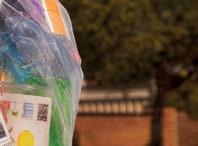

Every drink container returned helps the planet, your community and your pocket.




cdsvic.org. au




When you drive on less than five hours of sleep, you are four times more likely to crash. Do not drive tired. Consider an alternative mode of transport, postponing your trip, or get more sleep before driving.

“
I take the opportunity, during Holi, to thank Australians of Hindu faith for your contributions to your community and our country in many fields of endeavour.









